San Francisco
San Francisco | |
|---|---|
| City and County of San Francisco | |
 San Francisco from the Marin Headlands | |
|
St. Francis of Assisi | |
| Government | |
| • Type | Strong mayor–council |
| • Body | Board of Supervisors |
| • Mayor | London Breed (D)[6] |
| • Supervisors[10] | List
|
| • PDT) | |
| ZIP Codes[21] | List
|
GDP (2022)[23] | City—$252.2 billion
MSA—$729.1 billion (4th) CSA—$1.318 trillion (3rd) |
| Website | sf.gov |
| |
San Francisco,
Prior to
San Francisco and the surrounding
.In 2022, San Francisco had more than 1.7 million international visitors – the fifth-most visited city from abroad in the United States after New York City,
Etymology
San Francisco, which is Spanish for "Saint Francis," takes its name from Mission San Francisco de Asís, which in turn was named after Saint Francis of Assisi. The mission received its name in 1776, when it was founded by the Spanish under the leadership of Padre Francisco Palóu. The city has officially been known as San Francisco since 1847, when Washington Allon Bartlett, then serving as the city's alcalde, renamed it from Yerba Buena (Spanish for "Good Herb"), which had been name used throughout the Spanish and Mexican eras since approximately 1776. The name Yerba Buena continues to be used in locations in the city, such as on Yerba Buena Island and in the Yerba Buena Center for the Arts and Yerba Buena Gardens.
While residents outside the San Francisco Bay Area use nicknames including Frisco, San Fran, and SF, local residents in the Bay Area sometimes refer to San Francisco as "the City";[1] for residents of San Francisco living in the more suburban parts of the city, "the City" generally refers to the more densely populated downtown areas around Market Street. Its use, or lack thereof, is a common way for locals to distinguish long-time residents from tourists and recent arrivals. "San Fran" and "Frisco" are sometimes considered controversial as nicknames among San Francisco residents.[52][53][54]
History
Indigenous history
The earliest
Spanish era
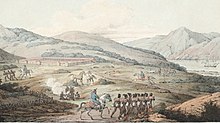
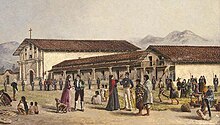
The
Soon after, on March 28, 1776, Anza established the Presidio of San Francisco. On October 9, Mission San Francisco de Asís, also known as Mission Dolores, was founded by Padre Francisco Palóu.[4] In 1794, the Presidio established the Castillo de San Joaquín, a fortification on the southern side of the Golden Gate, which later came to be known as Fort Point.
In 1804, the province of Alta California was created, which included Yerba Buena – the former name of San Francisco. At its peak in 1810–1820, the average population at the Mission Dolores settlement was about 1,100 people.[62]
Mexican era
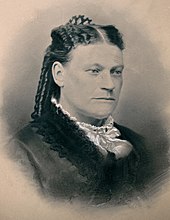
In 1821, the
In 1833, Juana Briones de Miranda built her rancho near El Polín Spring, founding the first civilian household in San Francisco, which had previously only been comprised by the military settlement at the Presidio and the religious settlement at Mission Dolores.[63]
In 1834,

Yerba Buena began to attract American and European settlers; an 1842 census listed 21 residents (11%) born in the United States or Europe, as well as one Filipino merchant.[67] Following the
Post-Conquest era


Despite its attractive location as a port and naval base, post-Conquest San Francisco was still a small settlement with inhospitable geography.[68] Its 1847 population was said to be 459.[64]
The
California was quickly
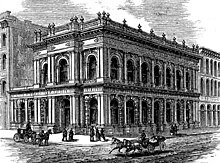
Entrepreneurs sought to capitalize on the wealth generated by the gold rush. Silver discoveries, including the Comstock Lode in Nevada in 1859, further drove rapid population growth.[77] With hordes of fortune seekers streaming through the city, lawlessness was common, and the Barbary Coast section of town gained notoriety as a haven for criminals, prostitution, bootlegging, and gambling.[78] Early winners were the banking industry, with the founding of Wells Fargo in 1852 and the Bank of California in 1864.
Development of the Port of San Francisco and the establishment in 1869 of overland access to the eastern U.S. rail system via the newly completed Pacific Railroad (the construction of which the city only reluctantly helped support[79]) helped make the Bay Area a center for trade. Catering to the needs and tastes of the growing population, Levi Strauss opened a dry goods business and Domingo Ghirardelli began manufacturing chocolate. Chinese immigrants made the city a polyglot culture, drawn to "Old Gold Mountain," creating the city's Chinatown quarter. By 1880, Chinese made up 9.3% of the population.[80]

The first
1906 earthquake and interwar era

At 5:12 am on April 18, 1906, a major

Rebuilding was rapid and performed on a grand scale. Rejecting calls to completely remake the street grid, San Franciscans opted for speed.
During this period, San Francisco built some of its most important infrastructure. Civil Engineer

In ensuing years, the city solidified its standing as a financial capital; in the wake of the
Contemporary era
During
Urban planning projects in the 1950s and 1960s involved widespread destruction and redevelopment of west-side neighborhoods and the construction of new

Over this period, San Francisco became a magnet for America's
Bank of America, now based in Charlotte, North Carolina, was founded in San Francisco; the bank completed 555 California Street in 1969. The Transamerica Pyramid was completed in 1972,[106] igniting a wave of "Manhattanization" that lasted until the late 1980s, a period of extensive high-rise development downtown.[107] The 1980s also saw a dramatic increase in the number of homeless people in the city, an issue that remains today, despite many attempts to address it.[108]

The 1989 Loma Prieta earthquake caused destruction and loss of life throughout the Bay Area. In San Francisco, the quake severely damaged structures in the Marina and South of Market districts and precipitated the demolition of the damaged Embarcadero Freeway and much of the damaged Central Freeway, allowing the city to reclaim The Embarcadero as its historic downtown waterfront and revitalizing the Hayes Valley neighborhood.[109]
The two recent decades have seen booms driven by the internet industry. During the dot-com boom of the late 1990s, startup companies invigorated the San Francisco economy. Large numbers of entrepreneurs and computer application developers moved into the city, followed by marketing, design, and sales professionals, changing the social landscape as once poorer neighborhoods became increasingly gentrified.[110] Demand for new housing and office space ignited a second wave of high-rise development, this time in the South of Market district.[111] By 2000, the city's population reached new highs, surpassing the previous record set in 1950. When the bubble burst in 2001 and again in 2023, many of these companies folded and their employees were laid off. Yet high technology and entrepreneurship remain mainstays of the San Francisco economy. By the mid-2000s (decade), the social media boom had begun, with San Francisco becoming a popular location for tech offices and a common place to live for people employed in Silicon Valley companies such as Apple and Google.[112]
The early 2020s featured an exodus of tech companies from Downtown San Francisco in the wake of the
The Ferry Station Post Office Building, Armour & Co. Building, Atherton House, and YMCA Hotel are historic buildings among dozens of historical landmarks in the city, according to the National Register of Historic Places listings in San Francisco.[117]
Geography
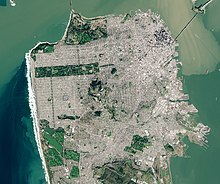
San Francisco is located on the
There are more than 50 hills within the city limits.[118] Some neighborhoods are named after the hill on which they are situated, including Nob Hill, Potrero Hill, and Russian Hill. Near the geographic center of the city, southwest of the downtown area, are a series of less densely populated hills. Twin Peaks, a pair of hills forming one of the city's highest points, forms an overlook spot. San Francisco's tallest hill, Mount Davidson, is 928 feet (283 m) high and is capped with a 103-foot (31 m) tall cross built in 1934.[119] Dominating this area is Sutro Tower, a large red and white radio and television transmission tower reaching 1,811 ft (552 m) above sea level.

The nearby
San Francisco's shoreline has grown beyond its natural limits. Entire neighborhoods such as the
Neighborhoods

The historic center of San Francisco is the northeast quadrant of the city anchored by
West of downtown, across
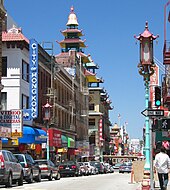
North of the Western Addition is Pacific Heights, an affluent neighborhood that features the homes built by wealthy San Franciscans in the wake of the 1906 earthquake. Directly north of Pacific Heights facing the waterfront is the Marina, a neighborhood popular with young professionals that was largely built on reclaimed land from the Bay.[133]
In the southeast quadrant of the city is the
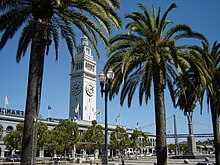
The construction of the Twin Peaks Tunnel in 1918 connected southwest neighborhoods to downtown via streetcar, hastening the development of West Portal, and nearby affluent Forest Hill and St. Francis Wood. Further west, stretching all the way to the Pacific Ocean and north to Golden Gate Park lies the vast Sunset District, a large middle-class area with a predominantly Asian population.[136]
The northwestern quadrant of the city contains the
Many piers remained derelict for years until the demolition of the
Climate
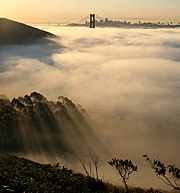
San Francisco has a
Among major U.S. cities, San Francisco has the coolest daily mean, maximum, and minimum temperatures for June, July, and August.[139] During the summer, rising hot air in California's interior valleys creates a low-pressure area that draws winds from the North Pacific High through the Golden Gate, which creates the city's characteristic cool winds and fog.[140] The fog is less pronounced in eastern neighborhoods and during the late summer and early fall. As a result, the year's warmest month, on average, is September, and on average, October is warmer than July, especially in daytime.
Temperatures reach or exceed 80 °F (27 °C) on an average of only 21 and 23 days a year at downtown and

The highest recorded temperature at the official National Weather Service downtown observation station[b] was 106 °F (41 °C) on September 1, 2017.[145] During that hot spell, the warmest ever night of 71 °F (22 °C) was also recorded.[146] The lowest recorded temperature was 27 °F (−3 °C) on December 11, 1932.[147]
During an average year between 1991 and 2020, San Francisco recorded a warmest night at 64 °F (18 °C) and a coldest day at 49 °F (9 °C).[141] The coldest daytime high since the station's opening in 1945 was recorded in December 1972 at 37 °F (3 °C).[141]
As a coastal city, San Francisco will be heavily affected by climate change. As of 2021[update], sea levels are projected to rise by as much as 5 feet (1.5 m), resulting in periodic flooding, rising groundwater levels, and lowland floods from more severe storms.[148]
San Francisco falls under the
| Month | Jan | Feb | Mar | Apr | May | Jun | Jul | Aug | Sep | Oct | Nov | Dec | Year |
|---|---|---|---|---|---|---|---|---|---|---|---|---|---|
| Record high °F (°C) | 79 (26) |
81 (27) |
87 (31) |
94 (34) |
97 (36) |
103 (39) |
99 (37) |
98 (37) |
106 (41) |
102 (39) |
86 (30) |
76 (24) |
106 (41) |
| Mean maximum °F (°C) | 67.1 (19.5) |
71.8 (22.1) |
76.4 (24.7) |
80.7 (27.1) |
81.4 (27.4) |
84.6 (29.2) |
80.5 (26.9) |
83.4 (28.6) |
90.8 (32.7) |
87.9 (31.1) |
75.8 (24.3) |
66.4 (19.1) |
94.0 (34.4) |
| Mean daily maximum °F (°C) | 57.8 (14.3) |
60.4 (15.8) |
62.1 (16.7) |
63.0 (17.2) |
64.1 (17.8) |
66.5 (19.2) |
66.3 (19.1) |
67.9 (19.9) |
70.2 (21.2) |
69.8 (21.0) |
63.7 (17.6) |
57.9 (14.4) |
64.1 (17.8) |
| Daily mean °F (°C) | 52.2 (11.2) |
54.2 (12.3) |
55.5 (13.1) |
56.4 (13.6) |
57.8 (14.3) |
59.7 (15.4) |
60.3 (15.7) |
61.7 (16.5) |
62.9 (17.2) |
62.1 (16.7) |
57.2 (14.0) |
52.5 (11.4) |
57.7 (14.3) |
| Mean daily minimum °F (°C) | 46.6 (8.1) |
47.9 (8.8) |
48.9 (9.4) |
49.7 (9.8) |
51.4 (10.8) |
53.0 (11.7) |
54.4 (12.4) |
55.5 (13.1) |
55.6 (13.1) |
54.4 (12.4) |
50.7 (10.4) |
47.0 (8.3) |
51.3 (10.7) |
| Mean minimum °F (°C) | 40.5 (4.7) |
42.0 (5.6) |
43.7 (6.5) |
45.0 (7.2) |
48.0 (8.9) |
50.1 (10.1) |
51.6 (10.9) |
52.9 (11.6) |
52.0 (11.1) |
49.9 (9.9) |
44.9 (7.2) |
40.7 (4.8) |
38.8 (3.8) |
| Record low °F (°C) | 29 (−2) |
31 (−1) |
33 (1) |
40 (4) |
42 (6) |
46 (8) |
47 (8) |
46 (8) |
47 (8) |
43 (6) |
38 (3) |
27 (−3) |
27 (−3) |
| Average precipitation inches (mm) | 4.40 (112) |
4.37 (111) |
3.15 (80) |
1.60 (41) |
0.70 (18) |
0.20 (5.1) |
0.01 (0.25) |
0.06 (1.5) |
0.10 (2.5) |
0.94 (24) |
2.60 (66) |
4.76 (121) |
22.89 (581) |
| Average precipitation days (≥ 0.01 in) | 11.2 | 10.8 | 10.8 | 6.8 | 4.0 | 1.6 | 0.7 | 1.1 | 1.2 | 3.5 | 7.9 | 11.6 | 71.2 |
| Average relative humidity (%)
|
80 | 77 | 75 | 72 | 72 | 71 | 75 | 75 | 73 | 71 | 75 | 78 | 75 |
| Mean monthly sunshine hours | 185.9 | 207.7 | 269.1 | 309.3 | 325.1 | 311.4 | 313.3 | 287.4 | 271.4 | 247.1 | 173.4 | 160.6 | 3,061.7 |
| Percent possible sunshine | 61 | 69 | 73 | 78 | 74 | 70 | 70 | 68 | 73 | 71 | 57 | 54 | 69 |
| Average ultraviolet index | 2 | 3 | 5 | 7 | 9 | 10 | 10 | 9 | 7 | 5 | 3 | 2 | 6 |
| Source 1: NOAA (sun 1961–1974)[141][151][152][153] | |||||||||||||
| Source 2: Met Office (humidity)[154], Weather Atlas (UV)[155] | |||||||||||||
Ecology

Historically,
Demographics
| Year | Pop. | ±% |
|---|---|---|
| 1848 | 1,000 | — |
| 1849 | 25,000 | +2400.0% |
| 1852 | 34,776 | +39.1% |
| 1860 | 56,802 | +63.3% |
| 1870 | 149,473 | +163.1% |
| 1880 | 233,959 | +56.5% |
| 1890 | 298,997 | +27.8% |
| 1900 | 342,782 | +14.6% |
| 1910 | 416,912 | +21.6% |
| 1920 | 506,676 | +21.5% |
| 1930 | 634,394 | +25.2% |
| 1940 | 634,536 | +0.0% |
| 1950 | 775,357 | +22.2% |
| 1960 | 740,316 | −4.5% |
| 1970 | 715,674 | −3.3% |
| 1980 | 678,974 | −5.1% |
| 1990 | 723,959 | +6.6% |
| 2000 | 776,733 | +7.3% |
| 2010 | 805,235 | +3.7% |
| 2020 | 873,965 | +8.5% |
| 2023 | 808,988 | −7.4% |
| https://www.sfchronicle.com/sf/article/s-f-exodus-population-recovery-data-18564064.php | ||
The 2020 United States census showed San Francisco's population to be 873,965, an increase of 8.5% from the 2010 census.[16] With roughly one-quarter the population density of Manhattan, San Francisco is the second-most densely populated large American city, behind only New York City among cities greater than 200,000 population, and the fifth-most densely populated U.S. county, following only four of the five New York City boroughs.
San Francisco is part of the five-county
Race, ethnicity, religion, and languages

As of the 2020[update] census, the racial makeup and population of San Francisco included: 361,382
San Francisco is a
In 2010, residents of
The population of Chinese ancestry is most heavily concentrated in Chinatown and theThe principal Hispanic groups in the city were those of Mexican (7%) and Salvadoran (2%) ancestry. The Hispanic population is most heavily concentrated in the Mission District, Tenderloin District, and Excelsior District.[164] The city's percentage of Hispanic residents is less than half of that of the state.
The city has long been home to a significant Jewish community; in 2018
Source: U.S. Census and IPUMS USA[169] | ||||||||||||||||||||||||||||||||||||||||||||||||||||||||||||||||||||||||||||||||||||||||||||||||||||||||||||||||||||||||||||||||||||||||||||
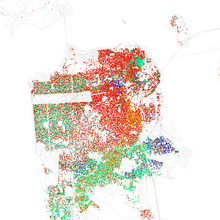
According to a 2018 study by the Jewish Community Federation of San Francisco, Jews make up 10% (80,000) of the city's population, making Judaism the second-largest religion in San Francisco after Christianity.
As of 2010[update], 55% (411,728) of San Francisco residents spoke only English at home, while 19% (140,302) spoke a
Ethnic clustering
San Francisco has several prominent Chinese, Mexican, and Filipino neighborhoods including Chinatown and the Mission District. Research collected on the immigrant clusters in the city show that more than half of the Asian population in San Francisco is either Chinese-born (40.3%) or Philippine-born (13.1%), and of the Mexican population 21% were Mexican-born, meaning these are people who recently immigrated to the United States.[176] Between the years of 1990 and 2000, the number of foreign-born residents increased from 33% to nearly 40%.[176] During this same time period, the San Francisco metropolitan area received 850,000 immigrants, ranking third in the United States after Los Angeles and New York.[176]
Education, households, and income

Of all major cities in the United States, San Francisco has the second-highest percentage of residents with a college degree, second only to Seattle. Over 44% of adults have a bachelor's or higher degree.[178] San Francisco had the highest rate at 7,031 per square mile, or over 344,000 total graduates in the city's 46.7 square miles (121 km2).[179]
San Francisco has the highest estimated percentage of gay and lesbian individuals of any of the 50 largest U.S. cities, at 15%.[180] San Francisco also has the highest percentage of same-sex households of any American county, with the Bay Area having a higher concentration than any other metropolitan area.[181]
San Francisco ranks third of American cities in median household income[182] with a 2007 value of $65,519.[183] Median family income is $81,136.[183] An emigration of middle-class families has left the city with a lower proportion of children than any other large American city,[184] with the dog population cited as exceeding the child population of 115,000, in 2018.[185] The city's
There are 345,811 households in the city, out of which: 133,366 households (39%) were individuals, 109,437 (32%) were
San Francisco declared itself a sanctuary city in 1989, and city officials strengthened the stance in 2013 with its 'Due Process for All' ordinance. The law declared local authorities could not hold immigrants for immigration offenses if they had no violent felonies on their records and did not currently face charges."[190] The city issues a Resident ID Card regardless of the applicant's immigration status.[191]
Homelessness
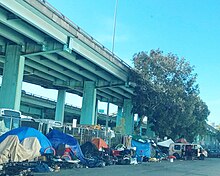
8,035 homeless people were counted in San Francisco's 2019 point-in-time street and shelter count. This was an increase of more than 17% over the 2017 count of 6,858 people. 5,180 of the people were living unsheltered on the streets and in parks.[193] 26% of respondents in the 2019 count identified job loss as the primary cause of their homelessness, 18% cited alcohol or drug use, and 13% cited being evicted from their residence.[193] The city of San Francisco has been dramatically increasing its spending to service the growing population homelessness crisis: spending jumped by $241 million in 2016–17 to total $275 million, compared to a budget of just $34 million the previous year. In 2017–18 the budget for combatting homelessness stood at $305 million.[194] In the 2019–2020 budget year, the city budgeted $368 million for homelessness services. In the proposed 2020–2021 budget the city budgeted $850 million for homelessness services.[195]
In January 2018 a United Nations special rapporteur on homelessness, Leilani Farha, stated that she was "completely shocked" by San Francisco's homelessness crisis during a visit to the city. She compared the "deplorable conditions" of the homeless camps she witnessed on San Francisco's streets to those she had seen in Mumbai.[194] In May 2020, San Francisco officially sanctioned homeless encampments.[196]
Crime
This article needs to be updated. (March 2024) |
San Francisco's violent crime rate is low compared to other major cities, though many residents are still concerned about it.[197] In 2011, 50 murders were reported, which is 6.1 per 100,000 people.[198] There were about 134 rapes, 3,142 robberies, and about 2,139 assaults. There were about 4,469 burglaries, 25,100 thefts, and 4,210 motor vehicle thefts.[199] The Tenderloin area has the highest crime rate in San Francisco: 70% of the city's violent crimes, and around one-fourth of the city's murders, occur in this neighborhood. The Tenderloin also sees high rates of drug abuse, gang violence, and prostitution.[200] Another area with high crime rates is the Bayview-Hunters Point area. In the first six months of 2015 there were 25 murders compared to 14 in the first six months of 2014. However, the murder rate is still much lower than in past decades.[201] That rate, though, did rise again by the close of 2016. According to the San Francisco Police Department, there were 59 murders in the city in 2016, an annual total that marked a 13.5% increase in the number of homicides (52) from 2015.[202] The city has also gained a reputation for car break-ins, with over 19,000 car break-ins occurring in 2021.[203]
During the first half of 2018, human feces on San Francisco sidewalks were the second-most-frequent complaint of city residents, with about 65 calls per day. The city has formed a "poop patrol" to attempt to combat the problem.[204]
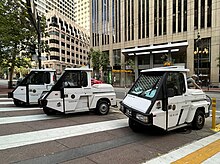
In January 2022,
Several
African-American street gangs familiar in other cities, including the
Criminal gangs with shotcallers in China, including Triad groups such as the Wo Hop To, were active in San Francisco in the 20th century.[210]
Economy
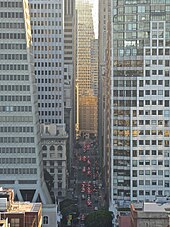
The city has a diversified

The legacy of the California gold rush turned San Francisco into the principal banking and finance center of the
Beginning in the 1990s, San Francisco's economy diversified away from finance and tourism towards the growing fields of high tech,

According to academic Rob Wilson, San Francisco is a global city, a status that pre-dated the city's popularity during the California gold rush.[231] However, the COVID-19 pandemic has led to high office vacancy rates and the closure of many retail and tech businesses in the downtown core of San Francisco.[232][233] Attributed causes include a shift to remote work in the technology and professional services sectors, as well as high levels of homelessness, drug use, and crime in areas around downtown San Francisco, such as the Tenderloin and Mid-Market neighborhoods.[234][235]
The top employer in San Francisco is the city government itself, employing 5.6% (31,000+ people) of the city's workforce, followed by
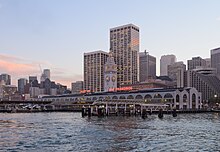
Like many U.S. cities, San Francisco once had a significant manufacturing sector employing nearly 60,000 workers in 1969, but nearly all production left for cheaper locations by the 1980s.[244] As of 2014[update], San Francisco has seen a small resurgence in manufacturing, with more than 4,000 manufacturing jobs across 500 companies, doubling since 2011. The city's largest manufacturing employer is Anchor Brewing Company, and the largest by revenue is Timbuk2.[244]
As of the first quarter of 2022[update], the median value of homes in San Francisco County was $1,297,030. It ranked third in the U.S. for counties with highest median home value, behind
Technology

San Francisco became a hub for technological driven economic growth during the
In the second technological boom driven by social media in the mid-2000s, San Francisco became a location for companies such as
Tourism and conventions

Tourism is one of San Francisco's most important private-sector industries, accounting for more than one out of seven jobs in the city.[221][250] The city's frequent portrayal in music, film, and popular culture has made the city and its landmarks recognizable worldwide. In 2016, it attracted the fifth-highest number of foreign tourists of any city in the United States.[251] More than 25 million visitors arrived in San Francisco in 2016, adding US$9.96 billion to the economy.[252] With a large hotel infrastructure and a major convention facility in the Moscone Center, San Francisco is a popular destination for annual conventions and conferences.[253]
Some of the most popular tourist attractions in San Francisco, as noted by the

San Francisco also offers tourists varied nightlife in its neighborhoods.[255][256]
The new Terminal Project at Pier 27 opened September 25, 2014, as a replacement for the old Pier 35.[257] Itineraries from San Francisco usually include round-trip cruises to Alaska and Mexico.
A heightened interest in conventioneering in San Francisco, marked by the establishment of convention centers such as Yerba Buena, acted as a feeder into the local tourist economy and resulted in an increase in the hotel industry: "In 1959, the city had fewer than thirty-three hundred first-class hotel rooms; by 1970, the number was nine thousand; and by 1999, there were more than thirty thousand."
Arts and culture
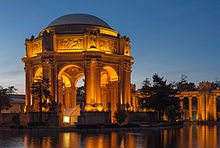
Although the
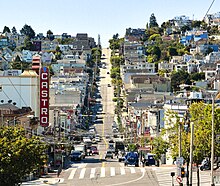
Since the 1990s, the demand for skilled
The international character that San Francisco has enjoyed since its founding is continued today by large numbers of immigrants from Asia and Latin America. With 39% of its residents born overseas,[239] San Francisco has numerous neighborhoods filled with businesses and civic institutions catering to new arrivals. In particular, the arrival of many ethnic Chinese, which began to accelerate in the 1970s, has complemented the long-established community historically based in Chinatown throughout the city and has transformed the annual Chinese New Year Parade into the largest event of its kind on the West Coast.
With the arrival of the
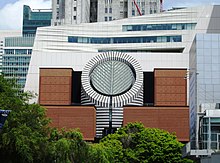
Since 1993, the San Francisco Department of Public Health has distributed 400,000 free syringes every month aimed at reducing HIV and other health risks for drug users, as well as providing disposal sites and services.[276][277][278]
San Francisco also has had a very active environmental community. Starting with the founding of the Sierra Club in 1892 to the establishment of the non-profit Friends of the Urban Forest in 1981, San Francisco has been at the forefront of many global discussions regarding the environment.[279][280] The 1980 San Francisco Recycling Program was one of the earliest curbside recycling programs.[281] The city's GoSolarSF incentive promotes solar installations and the San Francisco Public Utilities Commission is rolling out the CleanPowerSF program to sell electricity from local renewable sources.[282][283] SF Greasecycle is a program to recycle used cooking oil for conversion to biodiesel.[284]
The Sunset Reservoir Solar Project, completed in 2010, installed 24,000 solar panels on the roof of the reservoir. The 5-megawatt plant more than tripled the city's 2-megawatt solar generation capacity when it opened in December 2010.[285][286]
LGBT
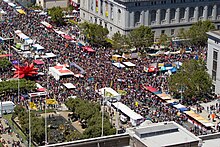
San Francisco has long had an

One of the most popular destinations for gay tourists internationally, the city hosts
The Folsom Street Fair (FSF) is an annual BDSM and leather subculture street fair that is held in September, endcapping San Francisco's "Leather Pride Week."[290] It started in 1984 and is California's third-largest single-day, outdoor spectator event and the world's largest leather event and showcase for BDSM products and culture.[291]
Performing arts


San Francisco's War Memorial and Performing Arts Center hosts some of the most enduring performing arts companies in the country. The War Memorial Opera House houses the San Francisco Opera, the second-largest opera company in North America[292] as well as the San Francisco Ballet, while the San Francisco Symphony plays in Davies Symphony Hall. Opened in 2013, the SFJAZZ Center hosts jazz performances year round.[293]
San Francisco has a large number of
Museums
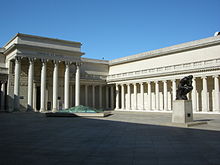
The San Francisco Museum of Modern Art (SFMOMA) houses 20th century and contemporary works of art. It moved to its current building in the South of Market neighborhood in 1995 and attracted more than 600,000 visitors annually.[300] SFMOMA closed for renovation and expansion in 2013. The museum reopened on May 14, 2016, with an addition, designed by Snøhetta, that has doubled the museum's size.[301]
The
Sports
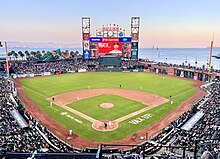
Major League Baseball's San Francisco Giants have played in San Francisco since moving from New York in 1958. The Giants play at Oracle Park, which opened in 2000.[304] The Giants won World Series titles in 2010, 2012, and in 2014. The Giants have boasted stars such as Willie Mays, Willie McCovey, and Barry Bonds (MLB's career home run leader). In 2012, San Francisco was ranked No. 1 in a study that examined which U.S. metro areas have produced the most Major Leaguers since 1920.[305]
The San Francisco 49ers of the National Football League (NFL) began playing in 1946 as an All-America Football Conference (AAFC) league charter member, moved to the NFL in 1950 and into Candlestick Park in 1971. The team left San Francisco in 2014, moving approximately 50 miles south to Santa Clara, and began playing its home games at Levi's Stadium,[306][307] The 49ers have won five Super Bowl titles between 1982 and 1995.

The NBA's Golden State Warriors have played in the San Francisco Bay Area since moving from Philadelphia in 1962. The Warriors played as the San Francisco Warriors, from 1962 to 1971, before being renamed the Golden State Warriors prior to the 1971–1972 season in an attempt to present the team as a representation of the whole state of California, which had already adopted "The Golden State" nickname.[308] The Warriors' arena, Chase Center, is located in San Francisco.[309] After winning two championships in Philadelphia, they have won five championships since moving to the San Francisco Bay Area,[310] and made five consecutive NBA Finals from 2015 to 2019, winning three of them. They won again in 2022, the franchise's first championship while residing in San Francisco proper.
At the collegiate level, the
There are a handful of lower-league soccer clubs in San Francisco playing mostly from April – June.
| Club | Founded | Venue | League | Tier level |
|---|---|---|---|---|
El Farolito
|
1985 | Boxer Stadium | NPSL | 4 |
| San Francisco City FC | 2001 | Kezar Stadium | USL League Two | 4 |
San Francisco Glens SC
|
1961 | Skyline College | USL League Two | 4 |
| SF Elite Metro | 2017 | Negoesco Stadium | NISA Nation | 5 |

The Bay to Breakers footrace, held annually since 1912, is best known for colorful costumes and a celebratory community spirit.[312] The San Francisco Marathon attracts more than 21,000 participants.[313] The Escape from Alcatraz triathlon has, since 1980, attracted 2,000 top professional and amateur triathletes for its annual race.[314] The Olympic Club, founded in 1860, is the oldest athletic club in the United States. Its private golf course has hosted the U.S. Open on five occasions. San Francisco hosted the 2013 America's Cup yacht racing competition.[315]
With an ideal climate for outdoor activities, San Francisco has ample resources and opportunities for amateur and participatory sports and recreation. There are more than 200 miles (320 km) of
San Francisco also has had Esports teams, such as the Overwatch League's San Francisco Shock. Established in 2017,[318] they won two back-to-back championship titles in 2019 and 2020.[319][320]
Parks and recreation
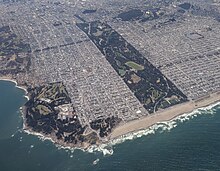
Several of San Francisco's parks and nearly all of its beaches form part of the regional Golden Gate National Recreation Area, one of the most visited units of the National Park system in the United States with over 13 million visitors a year. Among the GGNRA's attractions within the city are Ocean Beach, which runs along the Pacific Ocean shoreline and is frequented by a vibrant surfing community, and Baker Beach, which is located in a cove west of the Golden Gate.
The

There are more than 220 parks maintained by the San Francisco Recreation & Parks Department.[322] The largest and best-known city park is Golden Gate Park,[323] which stretches from the center of the city west to the Pacific Ocean. Once covered in native grasses and sand dunes, the park was conceived in the 1860s and was created by the extensive planting of thousands of non-native trees and plants. The large park is rich with cultural and natural attractions such as the Conservatory of Flowers, Japanese Tea Garden and San Francisco Botanical Garden.[citation needed]
Most of San Francisco's islands are protected as parkland or nature reserves. Alcatraz Island, operated by the National Park Service, is open to the public. The Farallon Islands are protected wildlife refuges. The Seal Rocks are protected as part of Golden Gate National Recreation Area. Red Rock Island is the only privately owned island in San Francisco Bay, but is uninhabited. Yerba Buena Island is largely utilized by the military.
San Francisco is the first city in the U.S. to have a park within a 10-Minute Walk of every resident.[326][327] It also ranks fifth in the U.S. for park access and quality in the 2018 ParkScore ranking of the top 100 park systems across the United States, according to the nonprofit Trust for Public Land.[328]
Government
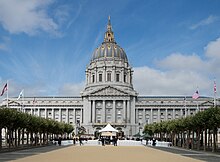
The
Because of its unique city-county status, the local government is able to exercise jurisdiction over certain property outside city limits.

The members of the Board of Supervisors are elected as representatives of specific districts within the city.
Most local offices in San Francisco are elected using ranked choice voting.[333]
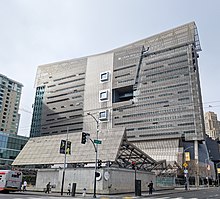
San Francisco serves as the regional hub for many arms of the federal bureaucracy, including the
The municipal budget for fiscal year 2015–16 was $8.99 billion,[335] and is one of the largest city budgets in the United States.[336] The City of San Francisco spends more per resident than any city other than Washington, D.C., over $10,000 in FY 2015–2016.[336] The city employs around 27,000 workers.[337]

In the
In the
Education
Colleges and universities

The
The University of California College of the Law, San Francisco, founded in Civic Center in 1878, is the oldest law school in California and claims more judges on the state bench than any other institution.[347] San Francisco's two University of California institutions have recently formed an official affiliation in the UCSF/UC Law SF Consortium on Law, Science & Health Policy.[348]

San Francisco State University is part of the California State University system and is located near Lake Merced.[349] The school has approximately 30,000 students and awards undergraduate, master's and doctoral degrees in more than 100 disciplines.[349] The City College of San Francisco, with its main facility in the Ingleside district, is one of the largest two-year community colleges in the country. It has an enrollment of about 100,000 students and offers an extensive continuing education program.[350]

Founded in 1855, the
With an enrollment of 13,000 students, the Academy of Art University is the largest institute of art and design in the nation.[352] Founded in 1871, the San Francisco Art Institute is the oldest art school west of the Mississippi.[353] The California College of the Arts, located north of Potrero Hill, has programs in architecture, fine arts, design, and writing.[354] The San Francisco Conservatory of Music, the only independent music school on the West Coast, grants degrees in orchestral instruments, chamber music, composition, and conducting.
The California Culinary Academy, associated with the Le Cordon Bleu program, offers programs in the culinary arts, baking and pastry arts, and hospitality and restaurant management. California Institute of Integral Studies, founded in 1968, offers a variety of graduate programs in its Schools of Professional Psychology & Health, and Consciousness and Transformation.
Primary and secondary schools

Just under 30% of the city's school-age population attends one of San Francisco's more than 100 private or parochial schools, compared to a 10% rate nationwide.[358] Nearly 40 of those schools are Catholic schools managed by the Archdiocese of San Francisco.[359]
San Francisco has nearly 300 preschool programs primarily operated by Head Start, San Francisco Unified School District, private for-profit, private non-profit and family child care providers.[360] All four-year-old children living in San Francisco are offered universal access to preschool through the Preschool for All program.[361]
Media
This section needs additional citations for verification. (January 2022) |

The major daily newspaper in San Francisco is the
The San Francisco Bay Area is the sixth-largest
All major U.S. television networks have

Infrastructure
Transportation
Public transportation
Transit is the most used form of transportation every day in San Francisco. Every weekday, more than 560,000 people travel on Muni's 69 bus routes and more than 140,000 customers ride the Muni Metro light rail system.
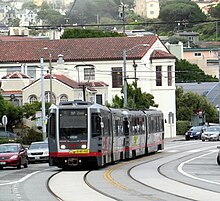
Another commuter rail system,
.Amtrak Thruway runs a shuttle bus from three locations in San Francisco to its station across the bay in Emeryville.[376] Additionally, BART offers connections to San Francisco from Amtrak's stations in Emeryville, Oakland and Richmond, and Caltrain offers connections in San Jose and Santa Clara. Thruway service also runs south to San Luis Obispo with connection to the Pacific Surfliner.
San Francisco was an early adopter of carsharing in America. The non-profit City CarShare opened in 2001[377] and Zipcar closely followed.[378]
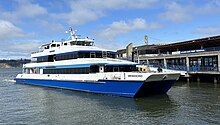
To accommodate the large amount of San Francisco citizens who commute to the Silicon Valley daily, employers like Genentech, Google, and Apple have begun to provide private bus transportation for their employees, from San Francisco locations. These buses have quickly become a heated topic of debate within the city, as protesters claim they block bus lanes and delay public buses.[381]
Freeways and roads

In 2014, only 41.3% of residents commuted by driving alone or carpooling in private vehicles in San Francisco, a decline from 48.6% in 2000.[382] There are 1,088 miles of streets in San Francisco with 946 miles of these streets being surface streets, and 59 miles of freeways.[382] Due to its unique geography, and the freeway revolts of the late 1950s,[383]
As part of the retrofitting of the Golden Gate Bridge and installation of a suicide barrier, starting in 2019 the railings on the west side of the pedestrian walkway were replaced with thinner, more flexible
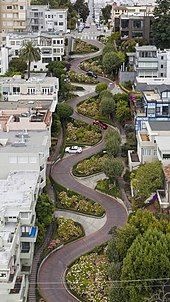
Vision Zero
In 2014, San Francisco committed to Vision Zero, with the goal of ending all traffic fatalities caused by motor vehicles within the city by 2024.[385] San Francisco's Vision Zero plan calls for investing in engineering, enforcement, and education, and focusing on dangerous intersections. In 2013, 25 people were killed by car and truck drivers while walking and biking in the city and 9 car drivers and passengers were killed in collisions. In 2019, 42 people were killed in traffic collisions in San Francisco.[386]
Airports

Though located 13 miles (21 km) south of downtown in unincorporated San Mateo County, San Francisco International Airport (SFO) is under the jurisdiction of the City and County of San Francisco. SFO is a hub for United Airlines[387] and Alaska Airlines.[388] SFO is a major international gateway to Asia and Europe, with the largest international terminal in North America.[389] In 2011, SFO was the eighth-busiest airport in the U.S. and the 22nd-busiest in the world, handling over 40.9 million passengers.[390]
Located in the South Bay, the San Jose International Airport (SJC) is the second-busiest airport in the Bay Area, followed by Oakland International Airport, which is a popular, low-cost alternative to SFO. Geographically, Oakland Airport is approximately the same distance from downtown San Francisco as SFO, but due to its location across San Francisco Bay, it is greater driving distance from San Francisco.[citation needed]
Cycling and walking

Cycling is a popular mode of transportation in San Francisco, with 75,000 residents commuting by bicycle each day.
San Francisco has significantly higher rates of pedestrian and bicyclist traffic deaths than the United States on average. In 2013, 21 pedestrians were killed in vehicle collisions, the highest since 2001,[398] which is 2.5 deaths per 100,000 population – 70% higher than the national average of 1.5.[399]
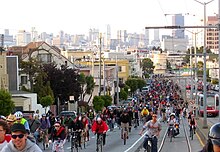
Cycling is becoming increasingly popular in the city. The 2010 Municipal Transportation Agency (MTA) annual bicycle count showed the number of cyclists at 33 locations had increased 58% from the 2006 baseline counts.[400] In 2008, the MTA estimated that about 128,000 trips were made by bicycle each day in the city, or 6% of total trips.[401] As of 2019[update], 2.6% of the city's streets have protected bike lanes, with 28 miles of protected bike lanes in the city.[371] Since 2006, San Francisco has received a Bicycle Friendly Community status of "Gold" from the League of American Bicyclists.[402] In 2022 a measure on the ballot passed to protect JFK drive in Golden Gate Park as a pedestrian and biking space with 59% of voters in favor.[403]
Public safety
The San Francisco Police Department was founded in 1849.[404] The portions of the Golden Gate National Recreation Area located within the city, including the Presidio and Ocean Beach, are patrolled by the United States Park Police.
The San Francisco Fire Department provides both fire suppression and emergency medical services to the city.[405]
Sister cities
San Francisco participates in the Sister Cities program.[406] A total of 41 consulates general and 23 honorary consulates have offices in the San Francisco Bay Area.[407]
In January 1980, Mayor Dianne Feinstein signed a sister cities agreement with Shanghai during a visit to China.[408]
Notable residents
See also
- San Francisco Bay Area
- List of cities and towns in California
- List of counties in California
- List of people from San Francisco
- Northern California megaregion
- Ships lost in San Francisco
- USS San Francisco, 3 ships
Notes
- ^ The land grant was near a boat anchorage around what is today Portsmouth Square.
- ^ Station currently at the United States Mint building[144][self-published source?]
- ^ The coordinates of the station are 37°46′14″N 122°25′37″W / 37.7706°N 122.4269°W. Precipitation, high temperature, low temperature, snow, and snow depth records date from October 1, 1849; June 1, 1874; January 1, 1875; January 1, 1876; and January 1, 1922; respectively.
- ^ Mean monthly maxima and minima (i.e. the expected highest and lowest temperature readings at any point during the year or given month) calculated based on data at said location from 1991 to 2020.
- ^ Those not born in the 50 states or D.C., excluding California, Nevada, Utah, Arizona, New Mexico, and Texas before 1850.
References
- ^ a b Garling, Caleb (June 30, 2013). "Don't Call It Frisco: The History of San Francisco's Nicknames". The Bold Italic. Retrieved June 18, 2016.
- ^ "San Francisco's Official Songs". Museum of San Francisco. Retrieved June 17, 2020.
- ^ 'Be it resolved: The official song of the City and County of San Francisco is, and shall remain, "San Francisco." Be it further resolved that henceforth: "I Left My Heart in San Francisco" shall be the official ballad.' San Francisco Administrative Code — Steven Short, KALW Public Media, May 10, 2021, "San Francisco’s Two Official Songs Or, The Day Tony Bennett Hid In His Hotel" [1]
- ^ a b c O'Day, Edward F. (October 1926). "The Founding of San Francisco". San Francisco Water. Spring Valley Water Authority. Archived from the original on July 27, 2010. Retrieved February 14, 2009.
- ^ "San Francisco: Government". SFGov.org. Archived from the original on March 16, 2012. Retrieved March 8, 2012.
San Francisco was incorporated as a City on April 15th, 1850 by act of the Legislature.
- ^ "Office of the Mayor : Home". City & County of San Francisco. Archived from the original on October 24, 2009. Retrieved July 11, 2018.
- ^ "Statewide Database". UC Regents. Archived from the original on February 1, 2015. Retrieved November 21, 2014.
- ^ "California's 11th Congressional District". GovTrack. Retrieved January 8, 2023.
- ^ "California's 15th Congressional District". GovTrack. Retrieved January 8, 2023.
- ^ "Board of Supervisors". City and County of San Francisco. Retrieved January 28, 2017.
- ^ "Communities of Interest – City". California Citizens Redistricting Commission. Archived from the original on October 23, 2015. Retrieved September 23, 2014.
- ^ "Members Assembly". California State Assembly. Retrieved September 23, 2014.
- ^ "2019 U.S. Gazetteer Files". United States Census Bureau. Retrieved July 1, 2020.
- ^ "San Francisco". Geographic Names Information System. United States Geological Survey, United States Department of the Interior.
- ^ a b "Elevations and Distances in the United States". US Geological Survey. April 29, 2005. Archived from the original on November 9, 2013. Retrieved October 29, 2014.
- ^ a b c "QuickFacts: San Francisco city, California". www.census.gov. United States Census Bureau. Retrieved March 14, 2024.
- ^ "List of 2020 Census Urban Areas". census.gov. United States Census Bureau. Retrieved January 8, 2023.
- ^ "Personal Income by County, Metro, and Other Areas". United States Bureau of Economic Analysis. Retrieved December 8, 2022.
- ^ "Metropolitan and Micropolitan Statistical Areas Population Totals and Components of Change: 2020–2021". United States Census Bureau. February 24, 2022. Retrieved August 13, 2022.
- SFGATE. San Francisco. Retrieved July 29, 2023.
- ^ "ZIP Codes for City of San Francisco, CA". 2010 United States census. 2010. Archived from the original on October 30, 2020. Retrieved March 14, 2021 – via Zip-Codes.com.
- ^ "NPA City Report". North American Numbering Plan Administration. Archived from the original on November 4, 2014. Retrieved November 5, 2014.
- ^ "Gross Domestic Product by County and Metropolitan Area, 2022" (PDF). www.bea.gov. Bureau of Economic Analysis.
- ^ (/ˌsæn frənˈsɪskoʊ/ SAN frən-SISS-koh; Spanish for 'Saint Francis')
- ^ "QuickFacts San Francisco County, California". United States Census Bureau. Retrieved May 17, 2023.
- 2010 United States Census Summary File 1. United States Census Bureau. Archived from the originalon February 13, 2020. Retrieved February 8, 2018.
- ^ a b "IPUMS NHGIS | National Historical Geographic Information System". www.nhgis.org. Retrieved December 8, 2023.
- ^ Brinklow, Adam (January 26, 2018). "Is it ever okay to use "San Fran?"". Curbed. Archived from the original on May 13, 2019. Retrieved August 31, 2019.
- ^ Rose, Aimee (September 9, 2015). "The Best Nicknames For San Francisco". The Culture Trip. Archived from the original on August 12, 2019. Retrieved August 21, 2019.
- ^ https://www.axios.com/local/san-francisco/2022/09/16/san-francisco-frisco-nickname-black
- ^ https://www.sfchronicle.com/bayarea/article/frisco-san-francisco-17411378.php
- ^ Coy, Owen Cochran (1919). Guide to the County Archives of California. Sacramento, California: California Historical Survey Commission. p. 409.
- ^ a b Montagne, Renée (April 11, 2006). "Remembering the 1906 San Francisco Earthquake". People & Places. NPR. Retrieved June 13, 2008.
- ^ a b "Port of Embarkation Essay—World War II in the San Francisco Bay Area". A National Register of Historic Places Travel Itinerary. US Department of the Interior. August 28, 2007. Archived from the original on June 24, 2011. Retrieved June 22, 2011.
- ^ "Charter of the United Nations | United Nations". Un.org. August 10, 2015. Retrieved December 29, 2016.
- ^ "History of the United Nations". Un.org. United Nations. August 21, 2015. Archived from the original on December 12, 2016. Retrieved December 29, 2016.
- ^ Schlesinger, Stephen (June 19, 2015). "San Francisco – the birthplace of the United Nations". San Francisco Chronicle. Retrieved December 29, 2016.
- ^ "Top 200 Science cities". Nature Index. Retrieved August 17, 2019.
- ^ "The Global Creative Economy Is Big Business". Retrieved August 17, 2019.
- ^ "2022 Best Global Universities Rankings". U.S. News & World Report.
- ^ "Regional Data: GDP and Personal Income". apps.bea.gov. Retrieved June 18, 2022.
- ^ "Metropolitan areas". stats.oecd.org. Retrieved September 17, 2022.
- ^ U.S. Bureau of Labor Statistics (January 1, 1947). "Consumer Price Index for All Urban Consumers: All Items in U.S. City Average". FRED, Federal Reserve Bank of St. Louis. Retrieved June 18, 2022.
- ^ "World Economic Outlook Database, April 2022". IMF. Retrieved June 18, 2022.
- ^ a b "Gross Domestic Product by County, 2022 | U.S. Bureau of Economic Analysis (BEA)". www.bea.gov. Retrieved December 8, 2023.
- ^ "The Global Financial Centres Index 34". www.longfinance.net. Retrieved December 8, 2023.
- ^ "America's 10 most visited cities", World Atlas, November 14, 2023
- ^ "San Francisco Travel Association Announces 2022 Results and 2023 Forecast" (Press release). San Francisco Travel. March 21, 2023. Retrieved December 7, 2023.
- ^ "Top U.S. Destinations for International Visitors". The Hotel Price Index. Archived from the original on March 27, 2014. Retrieved April 12, 2014.
- ^ Leins, Casey (April 3, 2019). "The 10 Best Cities for Public Transportation". USNews. Retrieved February 7, 2023.
- ^ "Direct flights from San Francisco (SFO) – FlightConnections". www.flightconnections.com. Retrieved February 7, 2023.
- ^ "Don't Call It 'Frisco': The History of San Francisco's Nicknames". The Bold Italic. December 20, 2019. Retrieved February 17, 2020.
- ^ Gilson, Dave. "Why San Francisco's "Frisco" debate will never, ever die". Mother Jones. Retrieved February 17, 2020.
- ^ Brinklow, Adam (January 26, 2018). "Is it ever okay to use "San Fran?"". Curbed SF. Retrieved February 17, 2020.
- ^ Stewart, Suzanne B. (November 2003). "Archaeological Research Issues for the Point Reyes National Seashore – Golden Gate National Recreation Area" (PDF). Sonoma State University – Anthropological Studies Center. Retrieved June 12, 2008.
- ^ "Visitors: San Francisco Historical Information". City and County of San Francisco. n.d. Archived from the original on March 1, 2006. Retrieved June 10, 2008.
- ^ Billiter, Bill (January 1, 1985). "3,000-Year-Old Connection Claimed : Siberia Tie to California Tribes Cited". Los Angeles Times. Retrieved September 25, 2023.
- ^ "Indigenous Peoples of San Mateo County". San Mateo County Office of Education. Retrieved January 18, 2024.
- ^ "The Association of Ramaytush Ohlone". The Association of Ramaytush Ohlone. Retrieved January 18, 2024.
- ^ "The Ramaytush Ohlone – Lessons on stewardship from the ancestral stewards of the Peninsula". Golden Gate National Parks Conservancy. December 4, 2018. Retrieved January 18, 2024.
- ^ Raup, H. F. "The Delayed Discovery of San Francisco Bay." California Historical Society Quarterly, vol. 27, no. 4, 1948, p. 293. JSTOR, https://www.jstor.org/stable/3816007. Accessed November 12, 2020.
- ^ Cleary, Brother Guire (January 31, 2003). "Mission Dolores Links San Francisco with its 18th Century Roots – Founded as La Mission San Francisco De Asis by Franciscans, it survived earthquake and fire". Catholic San Francisco. Archived from the original on February 5, 2007. Retrieved March 23, 2007.
- ^ a b Kamiya, Gary (August 23, 2013). "Juana Briones – San Francisco's founding mother". SFGATE.
- ^ a b c "From 1820 to the Gold Rush", at San Francisco Museum.org, accessed 2022.06.03.
- Two Years before the Mast(1840).
- ^ The Virtual Museum of the City of San Francisco (July 16, 2004). "From the 1820s to the Gold Rush". The Virtual Museum of the City of San Francisco. Archived from the original on October 22, 2009. Retrieved June 13, 2008.
- ^ "san_francisco_history:san_francisco_census_1842 [SFgenealogy]". www.sfgenealogy.org. Retrieved June 18, 2022.
- OCLC 44313415.
- JSTOR 1498306.
- ^ "San Francisco's First Brick Building". The Virtual Museum of the City of San Francisco. July 16, 2004. Retrieved June 13, 2008.
- OCLC 214330849.
- ^ Harris, Ron (November 14, 2005). "Crews Unearth Shipwreck on San Francisco Condo Project". Associated Press. Retrieved September 4, 2006.
- ^ Filion, Ron S. "Buried Ships". SFgenealogy. Retrieved April 19, 2016.
- ^ Report of Committee on Counties, January 4, 1850, revised to 27 counties on February 18, 1850 – Coy, Ph D., Owen C. (1923). California County Boundaries. Berkeley: California Historical Survey Commission. pp. 1–2.
- ^ Statutes of California and Digests of Measures. J. Winchester. 1856. p. 145.
- ^ Mathews, Joe (April 16, 2023). "Don't bank on California, especially when banks are involved". San Francisco Chronicle.
- OCLC 44313415.
- OCLC 44313415.
- ^ Construction of the Pacific Railroad was partially (albeit reluctantly) funded by the City and County of San Francisco Pacific Railroad Bond issue under the provisions of "An Act to Authorize the Board of Supervisors of the City and County of San Francisco to take and subscribe One Million Dollars to the Capital Stock of the Western Pacific Rail Road Company and the Central Pacific Rail Road Company of California and to provide for the payment of the same and other matters relating thereto." approved on April 22, 1863, as amended by §5 of the "Compromise Act of 1864" approved on April 4, 1864. The bond issue was objected to by the Mayor and the Board of Supervisors, however, and they were not delivered to the WPRR and CPRR until 1865 after Writs of Mandamus ordering such were issued by the Supreme Court of the State of California in 1864 ("The People of the State of California on the relation of the Central Pacific Railroad Company vs. Henry P. Coon, Mayor; Henry M. Hale, Auditor; and Joseph S. Paxson, Treasurer, of the City and County of San Francisco" 25 Cal 635) and 1865 ("The People ex rel The Central Pacific Railroad Company of California vs. The Board of Supervisors of the City and County of San Francisco, and Wilhelm Lowey, Clerk" 27 Cal 655)
- ^ "IPUMS USA". usa.ipums.org. Retrieved June 18, 2022.
- ^ "Under Three Flags" (PDF). Golden Gate National Recreation Area Brochures. US Department of the Interior. November 2004. Retrieved June 22, 2011.
- OCLC 44313415.
- PMID 11614219.
- ^ "1906 Earthquake: Fire Fighting". Golden Gate National Recreation Area. US Department of the Interior. December 24, 2003. Retrieved June 13, 2008.
- ^ "Casualties and Damage after the 1906 earthquake". Earthquake Hazards Program – Northern California. US Geological Survey. January 25, 2008. Retrieved June 13, 2008.
- ^ "1906 Earthquake and the Army". Golden Gate National Recreation Area. US Department of the Interior. August 25, 2004. Retrieved June 13, 2008.
- ^ "Jack London Writes of the 1906 San Francisco Earthquake and Fire". Sfmuseum.org. May 5, 1906. Retrieved June 15, 2013.
- OCLC 44313415.
- ^ "SPUR Our Mission and History". Retrieved March 26, 2013.
- ISBN 978-0-7385-5980-3.
- OCLC 44313415.
- ^ "Virtual Museum of the City of San Francisco – M.M. O'Shaughnessy Employed as City Engineer". Retrieved March 16, 2013.
- ^ "San Francisco Gold Rush Banking – 1849". The Virtual Museum of the City of San Francisco. June 24, 2004. Archived from the original on May 9, 2008. Retrieved June 13, 2008.
- ^ "Treasure Island History". timuseum. Retrieved August 5, 2021.
- ^ Kamiya, Gary (August 19, 2022). "The dark past of San Francisco's Sharp Park". San Francisco Chronicle. Archived from the original on August 19, 2022. Retrieved June 9, 2023.
- ^ Price, John (June 2001). "A Just Peace? The 1951 San Francisco Peace Treaty in Historical Perspective". Japan Policy Research Institute. Archived from the original on December 7, 2020. Retrieved December 8, 2020.
- ^ Fang, Eric (February 1999). "Urban Renewal Revisited: A Design Critique". SPUR Newsletter. San Francisco Planning and Urban Research Association. Archived from the original on October 11, 2009. Retrieved August 3, 2009.
- ^ Rubin, Jasper (November 1999). "The Decline of the Port – A look at the transformation of the Port of San Francisco". SPUR Newsletter. Retrieved January 5, 2013.
The final, insurmountable decline in San Francisco's shipping activity was heralded in 1958 by the departure of the first containerized freighter from San Francisco Bay.
- ^ Terplan, Egon (June 7, 2010). "Organizing for Economic Growth – A new approach to business attraction and retention in San Francisco". SPUR Report. Retrieved January 5, 2013.
During the 1960s and 1970s San Francisco's historic maritime industry relocated to Oakland. ... San Francisco remained a center for business and professional services (such as consulting, law, accounting and finance) and also successfully developed its tourism sector, which became the leading local industry.
- ^ Willis, James; Habib, Jerry; Brittan, Jeremy (April 19, 2004). "San Francisco Planning Department Census Data Analysis". San Francisco State University. Archived from the original (PPT) on July 18, 2011. Retrieved June 13, 2008.
- ^ Minton, Torri (September 20, 1998). "Race Through Time". San Francisco Chronicle. p. SC-4. Retrieved September 11, 2013.
- OCLC 44313415.
- ^ "American Experience: Summer of Love: Film Description". Website for American Experience documentary on the Summer of Love. PBS. March 14, 2007. Archived from the original on June 5, 2008. Retrieved June 17, 2008.
- ^ "Fear in the Streets of San Francisco". Time. April 29, 1974. Archived from the original on December 3, 2008. Retrieved August 28, 2006.
- ^ "San Francisco History: The 1970s and 1980s: Gay Rights". Destinations: San Francisco. Frommers.com. Archived from the original on July 18, 2001. Retrieved June 17, 2008.
- ^ "Pyramid Facts and Figures". Company Profile. Transamerica Insurance and Investment Group. Retrieved June 13, 2008.
- OCLC 44313415.
- ^ Fagan, Kevin (August 4, 2006). "S.F.'s Homeless Aging on the Street / Chronic health problems on the rise as median age nears 50". San Francisco Chronicle. Retrieved March 6, 2012.
The findings support what many social workers have long suspected – that there was a "big bang" homeless population explosion as federal housing programs were slashed and the closing of mental hospitals hit home in the mid-1980s and that this core group constitutes the bulk of the street population.
- ^ "Hayes Valley Neighborhood Association". Hayes Valley Neighborhood Association. Retrieved August 5, 2021.
- ^ Nieves, Evelyn (November 5, 2000). "Mission District Fights Case of Dot-Com Fever". The New York Times. Retrieved March 5, 2012.
- ^ Nolte, Carl (January 2, 2008). "High-rises are a sign of the times in changing San Francisco". San Francisco Chronicle. Retrieved July 9, 2012.
- ^ Ted Egan (April 3, 2006). "City and County of San Francisco: An Overview of San Francisco's Recent Economic Performance" (PDF). Report prepared for Mayor's Office of Economic and Workforce Development. ICF Consulting. Archived from the original (PDF) on February 1, 2009. Retrieved June 19, 2008.
Another positive trend for the future is San Francisco's highly entrepreneurial, flexible and innovative economy...San Francisco's very high reliance on small business and self-employment is typical of other dynamic, fast-growing, high-technology areas across the country.
- ^ Jim Carlton and Katherine Bindley (August 13, 2023). "Can San Francisco Save Itself From the Doom Loop?". The Wall Street Journal. Retrieved November 5, 2023.
- ^ Elizabeth Weil (May 10, 2023). "Spiraling in San Francisco's Doom Loop". Curbed. Retrieved November 5, 2023.
What it's like to live in a city that no longer believes its problems can be fixed.
- ^ J.D. Morris (October 30, 2023). "London Breed vs. the 'doom loop': How will S.F.'s mayor solve her biggest political problem?". San Francisco Chronicle. Retrieved November 5, 2023.
- ^ Wiley, Hannah (January 16, 2024). "All is lost in San Francisco? City loyalists take issue with naysayers. Data may back them up". Los Angeles Times. Retrieved April 4, 2024.
- ^ "NPGallery Search". National Park Service. Retrieved April 2, 2023.
- ^ Graham, Tom (November 7, 2004). "Peak Experience". San Francisco Chronicle. Hearst Communications. p. PK-23. Retrieved June 13, 2008.
- ^ Lee, Henry K. (January 16, 1997). "Mount Davidson Cross Called Landmark by Panel". San Francisco Chronicle. Retrieved June 17, 2008.
- ^ Smith, Charles (April 15, 2006). "What San Francisco didn't learn from the '06 quake". San Francisco Chronicle. Retrieved June 30, 2008.
- ^ Selna, Robert (June 29, 2008). "S.F. leaders ignore weak buildings' quake risk". San Francisco Chronicle. p. A-1. Retrieved June 30, 2008.
- California earthquake forecast.
- ^ "Liquefaction Damage in the Marina District during the 1989 Loma Prieta earthquake" (PDF). California Geological Survey. Retrieved June 17, 2008.
- ^ Matt Baume (April 14, 2010). "The Lure of the Creeks Buried Beneath San Francisco's Streets". Streetsblog San Francisco. Retrieved January 31, 2013.
- ^ The Official San Francisco Chinatown Website. Sanfranciscochinatown.com. Retrieved February 16, 2012.
- ^ Depicting Otherness: Images of San Francisco's Chinatown. College Street Journal (October 11, 2002). Retrieved February 16, 2012.
- ^ Bacon, Daniel: Walking the Barbary Coast Trail 2nd ed., pp. 52–53, Quicksilver Press, 1997
- ^ "Chinatown/Grant Avenue". Archived from the original on June 15, 2011. Retrieved August 31, 2010.. San Francisco Days
- ^ "S.F. supervisors OK Warriors arena for Mission Bay". San Francisco Chronicle. December 9, 2015. Retrieved February 8, 2016.
- ^ "Haight-Ashbury's Hippie House: Preserving San Francisco's 1960s Counterculture | National Trust for Historic Preservation". savingplaces.org. Retrieved August 5, 2021.
- ^ "The Haight". The San Francisco Chronicle. Retrieved August 3, 2009.
- ^ Bishop, Katherine (October 13, 1988). "Haight-Ashbury Journal; Love and Hate Linger in Ex-Hippie District". The New York Times. Retrieved August 3, 2009.
- ^ "The Marina". SFGate San Francisco Neighborhood Guide. October 27, 2011. Retrieved August 20, 2013.
- ^ Morgan, Benjamin (Director) (2007). "Quality of Life (film website)". Mission District History. Retrieved July 25, 2010.
- ^ "The Castro". The San Francisco Chronicle. Retrieved August 3, 2009.
- ^ Chow, Andrew (March 22, 2002). "Dismal APA Turnout at First Redistricting Meetings". Asian Week.
- ^ Climate of San Francisco: Narrative Description Golden Gate Weather Services. Retrieved September 5, 2006.
- ^ "San Francisco climate: Average Temperature, weather by month, San Francisco water temperature - Climate-Data.org". en.climate-data.org. Retrieved August 5, 2021.
- ^ Osborn, Liz. "Coolest US Cities in Summer". Weather Extremes. Current Results Nexus. Archived from the original on July 24, 2010. Retrieved July 25, 2010.
- ^ Gilliam, Harold (July–September 2002). "Cutting Through the Fog: Demystifying the Summer Spectacle". Bay Nature.
- ^ a b c d e f g h "NOAA Climate Data". National Oceanic and Atmospheric Administration. Retrieved February 6, 2019.
- ^ Climate of San Francisco: Snowfall Golden Gate Weather Services. Retrieved December 3, 2006.
- ^ Peter Hartlaub (November 29, 2012). "Blizzard of awesome: The San Francisco snowfall of 1976". San Francisco Chronicle. Retrieved February 1, 2013.
- ^ Dudley, Andrew (May 1, 2014). "Secretly Awesome: The Lower Haight Weather Station". hoodline.
- ^ Ruberstein, Steve; Asimov, Nanette; Lyons, Jenna (September 1, 2017). "San Francisco hits 106 degrees – shatters all-time record". San Francisco Chronicle. Retrieved September 2, 2017.
- NOAA. Retrieved July 26, 2022.
- ^ "San Fran Mission Dolore, California (047772) Period of Record General Climate Summary – Temperature". Western Regional Climate Center. Desert Research Institute. 2010. Archived from the original on May 13, 2011. Retrieved July 25, 2010. (Main page)
- ^ Tuma, Drew; Didion, Tim (August 10, 2021). "UN climate report puts focus on sea level rise threat to San Francisco Bay". ABC7 San Francisco. Retrieved January 31, 2022.
- ^ Agricultural Research Center, PRISM Climate Group Oregon State University. "USDA Plant Hardiness Zone Map". USDA. Archived from the original on February 27, 2014. Retrieved February 24, 2014.
- ^ "California Interactive USDA Plant Hardiness Zone Map". Retrieved December 19, 2016.
- ^ "Summary of Monthly Normals 1991–2020". National Oceanic and Atmospheric Administration. Retrieved May 5, 2021.
- ^ "Station Name: CA SAN FRANCISCO DWTN". National Oceanic and Atmospheric Administration. Retrieved March 18, 2014.
- ^ "San Francisco/Mission Dolores, CA Climate Normals 1961–1990". National Oceanic and Atmospheric Administration. Retrieved April 23, 2013.
- ^ "San Francisco holiday weather". Met Office. Retrieved September 18, 2017.
- ^ "Climate and monthly weather forecast San Francisco, CA". Retrieved August 16, 2022.
- . Retrieved May 27, 2020.
- ^ McCrossin, M. (1982). "Paleoecological inferences from a faunal analysis of CA-SFr-07". Journal of California and Great Basin Anthropology. 4: 138–141.
- ^ Herbert Eugene Bolton (1930). Anza's California Expeditions. Vol. I. An Outpost of Empire. Berkeley, California: University of California Press. p. 393.
- ISBN 9781441405401.
- ^ "QuickFacts: San Francisco County, California". US Census Bureau. Archived from the original on January 16, 2019. Retrieved April 5, 2019.
- ^ "Historical Census Statistics on Population Totals By Race, 1790 to 1990, and By Hispanic Origin, 1970 to 1990, For Large Cities And Other Urban Places in the United States". U.S. Census Bureau. Archived from the original on August 12, 2012. Retrieved December 18, 2011.
- ^ 2010 United States Census Summary File 1. United States Census Bureau. Archived from the originalon February 12, 2020. Retrieved July 11, 2011.
- ^ "Training and Education /PET". Filipino-American Law Enforcement Officers Association. Archived from the original on January 16, 2013. Retrieved April 28, 2012.
- ^ a b "Interactive: Mapping the census". The Washington Post. Archived from the original on May 13, 2011. Retrieved February 9, 2012.
- ^ "2020 Census: As San Francisco grew, the ethnic makeup of its neighborhoods changed. Here's how". September 27, 2021.
- ^ a b Ghert Zand, Renee (February 14, 2018). "Vast, young San Fran Jewish community is growing — but unaffiliated, says study". The Times of Israel. Times of Israel. Retrieved July 13, 2022.
- ^ "THE GUIDE TO JEWISH HERITAGE IN SAN FRANCISCO". San Francisco Travel Association. SF Travel. Retrieved July 13, 2022.
- ^ Shvetsky, Kate. "The Fillmore: A Jewish Neighborhood in the 1920s". Found SF. Retrieved July 13, 2022.
- ^ a b "IPUMS USA". usa.ipums.org. Retrieved February 25, 2022.
- ^ Bureau, US Census. "Race and Ethnicity in the United States: 2010 Census and 2020 Census". Census.gov. Retrieved February 25, 2022.
- ^ Major U.S. metropolitan areas differ in their religious profiles, Pew Research Center
- ^ "America's Changing Religious Landscape". Pew Research Center: Religion & Public Life. May 12, 2015.
- ^ "Chung: Chinese 'peasant' dialect redeemed – The Mercury News". December 22, 2007. Retrieved December 19, 2016.
- ^ "Chinatown Decoded: What Language Is Everybody Speaking?". Retrieved December 19, 2016.
- ^ "San Francisco County, California". Modern Language Association. Retrieved April 25, 2023.
- ^ .
- ^ "A Guide to San Francisco's Most Expensive Neighborhoods". www.california.com.
- ^ "The brainpower of America's largest cities". Bizjournals.com (data interpreted from U.S. Census). 2006. Archived from the original on July 1, 2006. Retrieved August 5, 2010.
- ^ Winter, Michael (June 9, 2010). "New measure ranks San Francisco the 'smartest' U.S. city". USA Today. Retrieved August 5, 2010.
- ^ Gates, Gary (October 2006). "Same-sex Couples and the Gay, Lesbian, Bisexual Population: New Estimates from the American Community Survey" (PDF). The Williams Institute, UCLA School of Law. Archived from the original (PDF) on July 2, 2007. Retrieved July 10, 2008.
- ^ "Gay and Lesbian Families in the United States: Same-Sex Unmarried Partner Households" (PDF). Human Rights Campaign. Archived from the original (PDF) on April 13, 2008. Retrieved August 26, 2006.
- ^ "Median Household Income (In 2003 Inflation-adjusted Dollars) (Place Level)". U.S. Census Bureau. August 22, 2007. Archived from the original on December 9, 2004. Retrieved June 23, 2009.
- ^ a b "QuickFacts: San Francisco County, California". United States Census Bureau. Archived from the original on July 13, 2011. Retrieved July 11, 2011.
- ^ Sankin, Aaron (March 9, 2012). "Families Flee San Francisco: City Has Lowest Percentage Of Kids Of Any Major U.S. City". HuffPost. Retrieved August 8, 2018.
- ^ Hendrix, Michael (November 21, 2018). "Young Americans' loneliness sets the table for Friendsgiving". The Washington Post. Retrieved November 21, 2018.
- ^ "Economic Characteristics". 2005–2009 American Community Survey 5-Year Estimates – Data Profile Highlights. U.S. Census Bureau. 2007. Archived from the original on February 11, 2020. Retrieved January 9, 2015.
- ^ "Deinstitutionalization: A Psychiatric 'Titanic'". PBS. Archived from the original on July 20, 2014. Retrieved August 9, 2014.
- ^ "San Francisco Program Combats Homelessness with Innovation". PBS. April 5, 2005. Archived from the original on January 10, 2012. Retrieved September 6, 2007.
- ^ Pratt, Timothy (August 12, 2006). "Critics say regional plan won't solve the problem". Las Vegas Sun. Retrieved August 30, 2006.
- ^ Carcamo, Cindy; Mather, Kate; Smith, Dakota (November 15, 2016). "Trump's crackdown on illegal immigration leaves a lot unanswered for sanctuary cities like L.A." Los Angeles Times. Retrieved December 5, 2019.
- ^ Buchanan, Wyatt (November 14, 2007). "S.F. supervisors approve ID cards for residents". San Francisco Chronicle. Retrieved April 17, 2019.
- ^ Saunders, Debra (August 9, 2015). "San Francisco's summer of urine and drug-addicted homeless". San Francisco Gate. Retrieved March 17, 2017.
- ^ a b "2019 San Francisco Homeless Count Report" (PDF). 2019.
- ^ a b Amy Graff (January 24, 2018). "UN expert on San Francisco homelessness: 'I couldn't help but be completely shocked'". SFGATE. Retrieved August 6, 2018.
- ^ "City & County of San Francisco, California Mayor's 2020–2021 & 2021–2022 Proposed Budget" (PDF). Archived from the original (PDF) on October 21, 2023.
- ^ "San Francisco sanctions once-shunned homeless encampments". ABC News. May 23, 2020.
- ^ "San Francisco's homicide rate is low compared to other big cities, but the killing of tech founder Bob Lee shows that doesn't tell the whole story". Business Insider.
- ^ Demian Bulwa (January 5, 2012). "Through hard times, S.F. killings at historic lows". San Francisco Chronicle. Retrieved July 29, 2013.
- ^ "San Francisco crime rates and statistics". NeighborhoodScout. Retrieved July 29, 2013.
- ^ "The Tenderloin". FoundSF. Retrieved July 29, 2013.
- ^ Vivian Ho (July 4, 2015). "Bay Area homicide rates remain low". San Francisco Chronicle.
- ^ Bodley, Michael (January 4, 2017). "SF cops say they notch 2 arrests in last 2 homicides of 2016." SFGate. Retrieved January 17, 2017.
- ^ Shaban, Bigad; Campos, Robert; Carroll, Jeremy; Villarreal, Mark (November 17, 2021). "Breaking Point: SF Suffers Highest Rate of Car Break-Ins Compared to Atlanta, DC, Dallas, LA". nbcbayarea.com. Retrieved July 12, 2022.
- ^ Knight, Heather (August 14, 2018). "It's no laughing matter — SF forming Poop Patrol to keep sidewalks clean". San Francisco Chronicle. Retrieved August 15, 2018.
- ^ Questions Raised After Suspect In Dozens Of Hate Crimes On SF Asian Businesses Found To Be Out Of Custody, CBS News, January 26, 2022, Archive
- ^ "La Mara Salvatrucha Street Gang". SF Weekly. Archived from the original on July 26, 2013. Retrieved July 29, 2013.
- ^ Bulwa, Demian (May 27, 2005). "SAN FRANCISCO / Sureño gang's threat growing in Bay Area / Widow's apartment is at heart of group's Mission District turf". San Francisco Chronicle. Retrieved March 29, 2014.
- ^ Albert Samaha (September 26, 2012). "Crip-less: S.F.'s Dislike of Franchises Extends to Street Gangs – Page 1 – News – San Francisco". SF Weekly. Retrieved July 29, 2013.
- ^ Chris Roberts (December 2015). "Mario Woods and Gang Injunctions". SF Weekly. Archived from the original on September 18, 2016. Retrieved September 5, 2016.
- ^ Mary Spicuzza (August 1, 2007). "Enter The Dragon". SF Weekly. Archived from the original on September 19, 2016. Retrieved September 5, 2016.
- ^ Noah Arroyo (June 10, 2022). "Downtown S.F. on the brink: It's worse than it looks". San Francisco Chronicle. Retrieved September 8, 2023.
- ^ a b "Industry Employment & Labor Force – by Annual Average for San Francisco County". California Employment Development Department. 2016.
- ^ U.S. Bureau of Economic Analysis (January 1, 2001). "Total Real Gross Domestic Product for San Francisco-Oakland-Hayward, CA (MSA)". FRED, Federal Reserve Bank of St. Louis. Retrieved January 5, 2021.
- ^ a b "GDP by County, Metro, and Other Areas". Bea.gov. Retrieved March 27, 2021.
- ^ "Personal Income by County, Metro, and Other Areas | U.S. Bureau of Economic Analysis (BEA)". Bea.gov. Retrieved January 5, 2021.
- ^ ISBN 978-0-520-26880-7.
- ^ "San Francisco: Economy". City-Data.com. Retrieved June 15, 2008.
- ^ "Fortune 500". Fortune magazine, Time Inc. 2013. Archived from the original on March 27, 2014. Retrieved April 6, 2014.
- ^ "The World According to GaWC 2012". Globalization and World Cities (GaWC) Study Group and Network. Loughborough University. Retrieved January 25, 2014.
- ^ "The Global Financial Centres Index 21" (PDF). China Development Institute. March 2017. Archived from the original (PDF) on September 18, 2018. Retrieved September 4, 2018.
- ^ a b Waters, Rob (May 15, 2009). "Biotech Jobs Germinate as San Francisco Diversifies Economy". Bloomberg. Archived from the original on October 23, 2015.
- ^ Warburg, Jennifer (February 27, 2014). "Forecasting San Francisco's Economic Fortunes". SPUR. Retrieved April 6, 2014.
- ^ Selna, Robert (May 15, 2008). "New jobs, houses spur S.F. population in 2007". San Francisco Chronicle. p. B-1. Retrieved June 14, 2008.
- ^ Garland, Russ (February 27, 2014). "As Bay Area Investment Shifts North, Institutional Venture Partners Opens San Francisco Office". The Wall Street Journal. Retrieved April 11, 2014.
- ^ "Startup City: The Urban Shift in Venture Capital and High Technology". Martin Prosperity Institute, Rotman School of Management, University of Toronto. March 31, 2014. Archived from the original on April 5, 2014. Retrieved April 6, 2014.
- ^ Florida, Richard (September 8, 2012). "San Francisco's urban tech boom". San Francisco Chronicle. Retrieved April 6, 2014.
- ^ Young, Eric (May 4, 2010). "S.F. extends biotech payroll tax exemption". San Francisco Business Times. Retrieved April 6, 2014.
- ^ "Life Sciences & Biotech" (Press release). San Francisco Center for Economic Development. Retrieved April 6, 2014.
- ^ "Mayor Lee Announces New Biotech Incubator in Mission Bay". Office of the Mayor, City and County of San Francisco. September 10, 2013. Retrieved April 6, 2014.
- ^ John King (March 3, 2024). "Union Square once was the center of San Francisco. Now it's off the map". San Francisco Chronicle. Retrieved March 3, 2024.
- S2CID 145302676.
- ^ Conor Dougherty and Emma Goldberg (December 17, 2022). "What Comes Next for the Most Empty Downtown in America – Tech workers are still at home. The $17 salad place is expanding into the suburbs. So what is left in San Francisco?". The New York Times. Retrieved December 17, 2022.
On any given week in San Francisco, office buildings are at about 40 percent of their prepandemic occupancy.
- ^ D'Innocenzio, Anne; Har, Janie (July 16, 2023). "Diversify or die: San Francisco's downtown is a wake-up call for other cities". AP News. Retrieved October 10, 2023.
- ^ Nellie Bowles (June 8, 2022). "HOW SAN FRANCISCO BECAME A FAILED CITY". The Atlantic. Retrieved June 27, 2023.
- ^ Truong, Kevin (October 24, 2022). "As Twitter Goes, So Goes a Revival of the Neighborhood It Helped Transform". The San Francisco Standard. Retrieved October 10, 2023.
- ^ "City and County of San Francisco, California Comprehensive Annual Financial Report, for the Year ended June 30, 2018" (PDF). p. 243. Retrieved May 10, 2019.
- ^ Li, Roland (November 14, 2018). "Salesforce to house 1,500 more workers in second Transbay tower". San Francisco Chronicle. Retrieved May 10, 2019.
- ^ Tan, Aldrich M. (April 12, 2006). "San Francisco is gateway city for immigrants and Silicon Valley Technology". Fogcityjournal.com. Retrieved June 15, 2008.
- ^ a b Egan, Ted (April 3, 2006). "An Overview of San Francisco's Recent Economic Performance – Executive Summary" (PDF). ICF Consulting. Archived from the original (PDF) on July 10, 2007. Retrieved June 14, 2008.
- ^ Said, Carolyn (November 29, 2005). "Main Street Fights Chain Street". San Francisco Chronicle. Retrieved August 27, 2006.
- ^ Hetter, Katia (March 21, 2004). "Supervisors OK limits on chain-store expansion". San Francisco Chronicle. Retrieved January 19, 2007.
- ^ "Proposition G: Limitations on Formula Retail Stores, City of San Francisco". smartvoter.org. Retrieved January 19, 2007.
- ^ "Nevada". Thumbtack. Retrieved October 21, 2016.
- ^ a b Frojo, Renée (February 14, 2014). "Made in San Francisco: Manufacturing a comeback". Retrieved April 6, 2014.
- ^ "County Median Home Price". National Association of Realtors. 2022. Archived from the original on April 20, 2022. Retrieved October 26, 2022.
- S2CID 154611136.
- ^ Cara Eisenpress (April 28, 2023). "New York is closer than ever to beating the Bay Area on tech". Crain Communications. Retrieved May 29, 2023.
- ^ Cara Eisenpress (May 22, 2023). "For the first time, Manhattan edges out San Francisco in new early-stage startups". Crain Communications. Retrieved October 14, 2023.
- ^ Egan (April 3, 2006). "City and County of San Francisco: An Overview of San Francisco's Recent Economic Performance" (PDF). Report prepared for Mayor's Office of Economic and Workforce Development. ICF Consulting. Archived from the original (PDF) on February 1, 2009. Retrieved December 6, 2017.
- ^ Flinn, Ryan (September 3, 2010). "S.F. tourism picks up, but spending stays flat". San Francisco Chronicle. p. D-1. Archived from the original on May 24, 2017. Retrieved February 4, 2012.
- ^ "Overseas Visitors to Select U.S. Cities 2015–2016" (PDF). National Travel and Tourism Office. International Trade Administration, US Department of Commerce. 2016. Archived from the original (PDF) on February 22, 2018. Retrieved February 22, 2018.
- ^ "San Francisco Travel Reports Record-Breaking Tourism in 2016". San Francisco Travel Association (Press release). January 18, 2017. Retrieved December 8, 2017.
- ^ "San Francisco Visitor Industry Statistics". San Francisco Travel Association. 2013. Retrieved April 5, 2014.
- ^ "Alcatraz Island : Explore Sensational San Francisco : TravelChannel.com". Travel Channel. Retrieved November 9, 2016.
- ^ "Top 20 Attractions in San Francisco". San Francisco Travel. Retrieved November 9, 2016.
- ^ McLean, Tessa (August 16, 2021). "San Francisco has almost 200 tiny streets. This is my favorite". SFGATE. Retrieved October 26, 2022.
- ^ "SFPort – James R. Herman Cruise Terminal Project at Pier 27". Retrieved March 16, 2013.
- ^ Hartman, Chester (2002). City for sale: The transformation of San Francisco. University of California Press. p. 24.
- S2CID 143916613.
- ^ "Most Walkable Cities in the U.S." Walkscore.com. Retrieved August 23, 2022.
- ^ Wach, Bonnie (October 3, 2003). "Fog City rises from the funk". USA Today. Archived from the original on May 15, 2006. Retrieved September 4, 2006.
- ^ "What's the Castro Like?". SFGate. Archived from the original on September 4, 2014. Retrieved July 30, 2014.
- ^ Schwarzer, Michelle (July 2001). "San Francisco by the Numbers: Planning After the 2000 Census". SPUR Newsletter. San Francisco Planning and Urban Research Association. Archived from the original on February 11, 2005. Retrieved July 25, 2010.
- ^ Sadovi, Maura Webber (April 12, 2006). "San Francisco's Home Prices Remain Among the Highest in U.S." The Wall Street Journal. Archived from the original on March 1, 2007. Retrieved June 14, 2008.
- ^ "Median Family Income (In 2003 Inflation-adjusted Dollars)". American Community Survey. US Census Bureau. August 22, 2007. Archived from the original on October 13, 2004. Retrieved June 14, 2008.
- ^ Hawn, Carleen (March 2007). "It may not feel like it, but your shot at the good life is getting better. Here's why". San Francisco magazine. Modern Luxury. Archived from the original on February 24, 2007. Retrieved June 14, 2008.
- ^ ""2014 Quality of Living worldwide city rankings – Mercer survey". Mercer Consulting. February 2014. Retrieved November 4, 2015.
- ^ Hendricks, Tyche (June 22, 2006). "Rich City Poor City: Middle-class neighborhoods are disappearing from the nation's cities, leaving only high- and low-income districts, new study says". San Francisco Chronicle. p. A-1. Retrieved June 14, 2008.
- ^ Anna Marie Erwert (June 2, 2015). "San Francisco's median rent hits a ridiculous $4,225". On The Block.
- ^ "Hot in the City." The Economist April 2, 2016: 71. print.
- ^ Leip, Dave (June 4, 2008). "Dave Leip's Atlas of U.S. Presidential Elections". Dave Leip. Retrieved June 14, 2008.
- ^ Reform Law Could Curb Healthy San Francisco's Enrollment by Up to 60% – California Healthline. Californiahealthline.org. Retrieved February 16, 2012.
- ^ "San Francisco's Latest Innovation: Universal Health Care", by Laura A. Locke, Time, June 23, 2006
- ^ "Participant Costs" Archived March 27, 2010, at the Wayback Machine, healthysanfrancisco.org. Retrieved April 10, 2010.
- ^ "Universal Health Care Plan Approved in San Francisco", Insurance Journal, July 20, 2006.
- ^ Those needles littering the streets? The city gave them out, San Francisco Chronicle, May 8, 2018
- ^ San Francisco's Free Syringes Are Littering Its Streets, CBS San Francisco, May 10, 2018
- ^ Johnson, Sydney (July 5, 2022). "Second-chance city: San Francisco's plan to reduce overdose crisis". The San Francisco Examiner. Archived from the original on March 19, 2022. Retrieved December 7, 2022.
- ^ "About the Sierra Club". Retrieved March 26, 2013.
- ^ "Friends of the Urban Forest – About us". Retrieved March 26, 2013.
- ^ "Recology Residential Service Program". Retrieved March 26, 2013.
- ^ "SFPUC GoSolarSF". Retrieved March 26, 2013.
- ^ "About Clean Power SF". Archived from the original on February 20, 2015. Retrieved February 21, 2015.
- ^ "SFPUC Greasecycle". Retrieved March 26, 2013.
- ^ "Mayor Newsom Praises SFPUC For Approving New Five Megawatt Solar Project at Sunset Reservoir" (Press release). Office of the Mayor, San Francisco. December 12, 2008. Retrieved September 29, 2009.
- ^ Leigh Glaser (December 7, 2010). "SF gets new way to generate renewable energy". KGO ABC7 News. Archived from the original on April 10, 2014. Retrieved April 13, 2013.
- ^ "San Francisco Metro Area Ranks Highest in LGBT Percentage". Gallup.com. March 20, 2015.
- ^ "San Francisco Pride". March 2023. Archived from the original on March 26, 2023. Retrieved March 26, 2023.
- ^ "Court victories boost gay pride parades". USA Today.
- ISBN 978-0692183731.
- ^ "Cheap date – what to do?". CNN.[permanent dead link]
- ^ "San Francisco Opera | San Francisco Classical Voice". www.sfcv.org. Retrieved December 29, 2021.
- ^ "SFJAZZ.org | About". www.sfjazz.org. Retrieved December 29, 2021.
- ^ "SAN FRANCISCO SOUND". www.shsu.edu. Retrieved August 5, 2021.
- ^ "Remembering The Most Iconic Classic Rock Venue On The West Coast". May 24, 2018. Retrieved April 2, 2023.
- ^ "Stage Left: San Francisco's Theater History". 7x7 Bay Area. November 9, 2012.
- ^ Jones, Chad. "Tonys By the Bay". Theatre Bay Area Magazine, May/June 2014.
- ^ Sanders, Adrienne, "S.F. Raises Curtain For Broadway Hits" San Francisco Business Times, April 3, 2005. [2]
- ^ Jones, Chad. "Tonys By the Bay". Theatre Bay Area Magazine, May/June 2014. [3]
- ^ "Corporate Sponsorship – Why Sponsor". San Francisco Museum of Modern Art. Archived from the original on December 29, 2007. Retrieved June 14, 2008.
- ^ "Our Expansion · SFMOMA". SFMOMA.
- ^ "Museums in San Francisco". SanFrancisco.net. Retrieved November 15, 2015.
- ^ "CCA Wattis Institute for Contemporary Arts". wattis.org. Retrieved February 20, 2024.
- ^ "Federal Brownfields Tax Incentive: SBC Park" (PDF). Brownfields. US Environmental Protection Agency. May 2005. Archived from the original (PDF) on September 21, 2006. Retrieved June 15, 2008.
- ^ Sperling, Bert (October 25, 2012). "Best Baseball Cities". Retrieved October 29, 2012.
- ^ Matier, Phillip; Ross, Andrew (November 9, 2006). "SAN FRANCISCO / 49ers say they are moving to Santa Clara". San Francisco Chronicle. Retrieved March 28, 2012.
- ^ "San Francisco mayor: 49ers move to Santa Clara all but assured". PressDemocrat.com. December 6, 2011. Retrieved March 28, 2012.
- ^ "Behind The Name – Warriors | THE OFFICIAL SITE OF THE GOLDEN STATE WARRIORS". Nba.com. Retrieved November 9, 2016.
- ^ Coliseum, Oracle Arena and Oakland-Alameda County. "Golden State Warriors | Oracle Arena and Oakland-Alameda County Coliseum". Oraclearena.com. Archived from the original on December 9, 2016. Retrieved November 9, 2016.
- ^ "Golden State Warriors Win 2022 NBA Championship: Warriors Earn Seventh Title in Franchise History". NBA. June 16, 2022. Retrieved June 17, 2022.
- ^ "Athletics and Sports – San Francisco State University Bulletin 2013 – 2014". Sfsu.edu. Retrieved November 9, 2016.
- ^ "About Us – History". ING Bay to Breakers. ING Group. March 11, 2008. Archived from the original on November 24, 2012. Retrieved July 25, 2010.
- Press Release. Retrieved September 7, 2010.
- Press Release. Accenture Escape from Alcatraz Triathlon. May 23, 2008. Archived from the original(PDF) on January 25, 2009. Retrieved January 19, 2009.
- ^ Cote, John (2010). "San Francisco selected to host America's Cup". San Francisco Chronicle. Retrieved September 11, 2013.
- ^ "Bicycle Network Facilities". Commuting and Resources. SF Municipal Transportation Authority. May 12, 2008. Archived from the original on April 4, 2013. Retrieved June 15, 2008.
- ^ Hübler, Eric (2008). "The Fittest and Fattest Cities in America". Men's Fitness. Archived from the original on October 11, 2008. Retrieved June 15, 2008.
- ^ Lautenbach, Brett (October 16, 2017). "Esports Comes to Shake Up Northern California: Meet the San Francisco Shock". www.businesswire.com. Retrieved April 23, 2021.
- ^ Samples, Rachel (September 29, 2019). "San Francisco Shock crowned 2019 Overwatch League champions". Dot Esports. Retrieved April 23, 2021.
- ^ Amin, Justin (October 10, 2020). "San Francisco Shock are 2020 Overwatch League Champions". Esportz Network. Archived from the original on June 7, 2023. Retrieved April 23, 2021.
- ^ Brinklow, Adam (August 22, 2018). "Golden Gate Park ranked third most popular park in US". Curbed SF. Retrieved November 13, 2019.
- ^ "Facility Listings". San Francisco Recreation and Parks Department. City and County of San Francisco. Archived from the original on August 16, 2010. Retrieved July 25, 2010.
- ^ "The Most Visited City Parks" (PDF). Center for City Park Excellence. The Trust for Public Land. October 11, 2007. Archived from the original (PDF) on March 18, 2009. Retrieved June 17, 2008.
- ^ "What to See at the Zoo". San Francisco Zoo. Archived from the original on July 19, 2011. Retrieved June 14, 2008.
- ^ "Candlestick Point SRA". California State Parks Department. Retrieved January 27, 2009.
- ^ "SF 1st city in nation with a park 10-minute walk from every home". San Francisco Chronicle. Retrieved May 23, 2018.
- ^ "In San Francisco, Everyone Lives Within A 10-Minute Walk of a Park". CBS SF Bay Area. May 16, 2017. Retrieved May 23, 2018.
- ^ "ParkScore". Parkscore.tpl.org. Archived from the original on May 24, 2018. Retrieved May 23, 2018.
- ^ "Board of Supervisors – Does San Francisco have a City Council?". Archived from the original on August 26, 2008. Retrieved October 28, 2015.
- ^ "Board of Supervisors – Does San Francisco have a City Council?". SFGov SF311. Archived from the original on November 29, 2010. Retrieved June 16, 2008.
- ^ "Board of Supervisors District Information". City and County of San Francisco, Board of Supervisors. Archived from the original on July 14, 2007. Retrieved January 29, 2006.
- ^ Coté, John (January 11, 2011). "Ed Lee becomes the city's first Chinese American mayor". The San Francisco Chronicle. Archived from the original on October 12, 2013.
- ^ "Ranked-choice voting | San Francisco". sf.gov. Retrieved September 13, 2023.
- ^ "Foreign Consular Offices in the United States, 2007" (PDF). United States Department of State. Retrieved December 12, 2008.
- ^ "Budget and Appropriation Ordinance as of July 21, 2015 – Fiscal Years Ending June 30, 2016 and June 30, 2017" (PDF). SF Controller. July 21, 2015. Retrieved April 16, 2020.
- ^ a b "Analysis of spending in America's largest cities – Ballotpedia". Retrieved March 16, 2017.
- ^ Gordon, Rachel (April 26, 2010). "1 in 3 San Francisco employees earned $100,000". San Francisco Chronicle. Retrieved March 7, 2012.
- ^ "Communities of Interest — County". California Citizens Redistricting Commission. Archived from the original on October 23, 2015. Retrieved September 28, 2014.
- ^ "California's 12th Congressional District - Representatives & District Map". Civic Impulse, LLC. Retrieved March 12, 2013.
- ^ "America's Best Graduate Schools: Best Medical Schools". U.S. News & World Report. 2010. Archived from the original on April 21, 2010. Retrieved July 25, 2010.
- ^ Comarow, Avery (July 14, 2010). "Best Hospitals 2011–12: the Honor Roll". U.S. News & World Report. Retrieved July 25, 2010.
- ^ "San Francisco Business Information: Largest Employers in San Francisco". San Francisco Business Times Book of Lists, 2007. San Francisco Center for Economic Development. Archived from the original (Microsoft Word) on August 17, 2007. Retrieved June 9, 2008.
- San Francisco Business Times. Archivedfrom the original on June 16, 2010. Retrieved July 26, 2010.
- ^ "Employment & Economic Stimulus". 2010 Economic Impact Report. University of California, San Francisco. Archived from the original on July 1, 2010. Retrieved July 26, 2010.
- ^ Wallace Ravven (July 22, 2003). "New UCSF Mission Bay campus: country's largest biomedical university expansion". UCSF. Retrieved June 9, 2008.
- ^ UCSF (2015). "Locations". Retrieved February 21, 2015.
- ^ "Hastings Quick Facts". University of California, Hastings College of the Law. Retrieved August 30, 2006.
- ^ "UCSF/UC Hastings Consortium". University of California, Hastings College of the Law. Archived from the original on April 26, 2013. Retrieved June 2, 2013.
- ^ a b "SF State Facts 2008–2009" (PDF). SFSU. Retrieved March 7, 2009.
- ^ "City College of San Francisco Fact Sheet". City College of San Francisco. April 2008. Archived from the original (PDF) on December 2, 2008. Retrieved June 16, 2008.
- ^ "University of San Francisco Fact Book and Almanac 2007" (PDF). University of San Francisco. December 31, 2007. Archived from the original (PDF) on June 24, 2008. Retrieved July 25, 2010.
- ^ "Who We Are". Academy of Art University. 2008. Retrieved February 18, 2009.
- ISBN 9780312361822. Retrieved February 18, 2009.
- ^ "Oakland & San Francisco Campuses". California College of the Arts. 2012. Retrieved May 23, 2012.
- U.S. Census Bureau. Retrieved July 22, 2022. – Text list
- ^ "The Oldest Public High School West of the Mississippi". About Lowell: Lowell History. San Francisco Unified School District. February 22, 2002. Archived from the original on April 14, 2002. Retrieved July 25, 2010.
- ^ Jill Tucker (June 10, 2015). "S.F. board sticks with school-assignment system". San Francisco Chronicle.
- ^ Knight, Heather (May 31, 2006). "Many reluctantly chose private schools". San Francisco Chronicle. p. A-1. Retrieved June 16, 2008.
- ^ "School Directory August 2010" (PDF). Roman Catholic Archdiocese of San Francisco. August 2010. Archived from the original (PDF) on November 27, 2010. Retrieved January 23, 2011.
- ^ "Preschools in San Francisco". Winnie. Retrieved May 18, 2017.
- ^ "Preschool for All". San Francisco Office of Early Care and Education. Archived from the original on May 24, 2017. Retrieved May 18, 2017.
- ^ "Top 200 Newspapers by Largest Reported Circulation". Audit Bureau of Circulations. March 31, 2007. Archived from the original on August 13, 2007. Retrieved June 14, 2008.
- ^ Rosenberg, Scott (March 21, 2000). "The San Francisco Examiner, 1887–2000". Salon. Archived from the original on June 27, 2009. Retrieved June 15, 2008.
- ^ Nolte, Carl (November 22, 2000). "Examiner Staff Ends an Era With Tears, Newsroom Tales". San Francisco Chronicle. p. A-1. Retrieved June 15, 2008.
- ^ Hua, Vanessa (August 3, 2004). "Newspaper war in the Bay Area: Ming Pao becomes 6th Chinese-language daily". San Francisco Chronicle. p. B-1. Retrieved June 14, 2008.
- ^ "Local Television Market Universe Estimates". September 22, 2007. Archived from the original (XLS) on September 27, 2007. Retrieved June 15, 2008.
- ^ "Arbitron Radio Market Rankings: Spring 2008". Arbitron. April 16, 2008. Archived from the original on July 10, 2007. Retrieved June 14, 2008.
- ^ "Top 30 Public Radio Subscribers – Winter 2004 Arbitron" (PDF). Radio Research Consortium. Arbitron Media Research. June 17, 2004. Archived from the original (PDF) on April 23, 2005. Retrieved June 14, 2008.
- ^ "About – KUSF". www.kusf.org. Retrieved April 2, 2023.
- ^ "KPOO – About Us". kpoo.com.
- ^ a b "SFMTA 2019 Annual Report" (PDF). Sfmta.com. Retrieved April 16, 2021.
- ^ Les Christie (June 29, 2007). "New Yorkers are Top Transit Users". CNNMoney.com. Retrieved August 20, 2008.
- ^ "Largest U.S. transit agencies based on passenger trips". Statista. Retrieved January 1, 2024.
- ^ a b c d e "Bay Area Traveler: Transportation Information". San Francisco Chronicle Inc. March 2007. Archived from the original on August 30, 2008. Retrieved June 16, 2008.
- ^ "Report on San Francisco's Cable Cars" (PDF). San Francisco Beautiful. May 2007. Retrieved June 16, 2008.
- ^ "Emeryville Station (EMY)". Amtrak. Retrieved July 25, 2010.
- ^ "City CarShare Out Mission". Retrieved March 26, 2013.
- ^ "Zipcar Our Mission". Retrieved March 26, 2013.
- ^ "San Francisco Bay Ferry". Retrieved March 26, 2013.
- ^ "Golden Gate Ferry". Retrieved March 26, 2013.
- ^ "Google bus blocked in San Francisco protest vs gentrification". Reuters. December 9, 2016. Retrieved November 9, 2016.
- ^ a b "SFMTA Transportation Fact Sheet" (PDF). 2015.
- ^ a b Gordon, Rachel (September 8, 2005). "Boulevard of dreams, the premiere". San Francisco Chronicle. p. B-1. Retrieved June 16, 2008.
- ^ Ting, Eric (June 6, 2020). "Why the Golden Gate Bridge made strange noises with the wind Friday". San Francisco Chronicle. Archived from the original on July 5, 2020. Retrieved July 5, 2020.
- ^ Kwong, Jessica (February 19, 2014). "SF takes step forward in education for pedestrians, cyclists and drivers". San Francisco Examiner. Archived from the original on February 26, 2014. Retrieved February 26, 2014.
- ^ "Vision Zero 2019 End of Year Traffic Fatality Report" (PDF). 2019.
- ^ Young, Eric (April 2, 2004). "Pact keeps United from flying away". San Francisco Business Times. Retrieved June 16, 2008.
- ^ "Alaska Air Group closes acquisition of Virgin America, becomes the 5th largest U.S. airline". December 14, 2016. Retrieved February 24, 2019.
- ^ "Fact Sheet: International Terminal" (PDF). San Francisco International Airport. May 2007. Archived from the original (PDF) on August 7, 2013. Retrieved June 16, 2008.
- ^ "Preliminary World Airport Traffic 2011 (Table 2 – Total Passenger Traffic 2011)" (PDF). Airports Council International. March 27, 2012. Retrieved April 22, 2012.
- ^ "2011 Bicycle Count Report" (PDF). SFMTA. City of San Francisco. December 2011. Retrieved May 17, 2012.
- ^ 2012 San Francisco State of Cycling Report (PDF) (Report). San Francisco Municipal Transportation Agency. 2012. p. 2. Retrieved October 24, 2015.
- ^ Bialick, Aaron (June 29, 2017). "Ford GoBike Launches, Bringing Bike-Share to New SF Neighborhoods". SFMTA: Municipal Transportation Agency. Retrieved April 30, 2018.
- ^ "Grab an ebike and go". Ford GoBike. Archived from the original on December 17, 2017. Retrieved April 30, 2018.
- ^ Said, Carolyn (July 20, 2011). "S.F., Oakland in top 10 most walkable U.S. cities". San Francisco Chronicle. Retrieved July 20, 2011.
- ^ "The 10 most walkable U.S. cities". MarketWatch. 2011. Retrieved July 20, 2011.
- ^ "Walk Score Ranks The Most Walkable Cities of 2015 – @Redfin". April 7, 2015. Retrieved September 25, 2015.
- ^ Sabatini, Joshua (January 16, 2014). "Lee unveils push for pedestrian safety". SF Examiner. Retrieved January 19, 2014.
- ^ "Traffic Safety Facts, 2012 Motor Vehicle Crashes: Overview" (PDF). National Highway Traffic Safety Administration. Retrieved January 19, 2014.
- ^ "City of San Francisco 2010 Bicycle Count Report" (PDF). San Francisco Municipal Transportation Agency, 2010, p. 3.
- ^ "2008 San Francisco State of Cycling Report" (PDF). San Francisco Municipal Transportation Agency. 2008. p. 9. Retrieved October 1, 2014.
- ^ "Bicycle Friendly America 2010" (PDF). American Bicyclist: 17. 2010. Retrieved October 24, 2015.
- ^ Cano, Ricardo (November 9, 2022). "JFK Drive will remain car-free after S.F. voters reject Prop. I, pass Prop. J". San Francisco Chronicle. Retrieved December 5, 2022.
- ^ "SFPD History". San Francisco Police Department. Archived from the original on March 1, 2017. Retrieved February 28, 2017.
- ^ "Fire Commission Response to Grand Jury Report". San Francisco Fire Department. Archived from the original on February 13, 2017. Retrieved February 12, 2017.
- ^ "San Francisco Sister Cities". Retrieved February 1, 2017.
- ^ "REGISTER OF FOREIGN CONSULATES IN SAN FRANCISCO" (PDF). Archived from the original (PDF) on November 23, 2014. Retrieved March 11, 2013.
- ISBN 978-1-5381-8725-8.
Bibliography
- De La Perouse, Jean Francois; Yamane, Linda Gonsalves; Margolin, Malcolm (1989). Life in a California Mission: Monterey in 1786: The Journals of Jean Francois De La Perouse. OCLC 20368802.
- OCLC 30702907.
- London, Jack (May 5, 1906). "The Story of an Eyewitness by Jack London". Collier's, the National Weekly.
- Richards, Rand (1991). Historic San Francisco: A Concise History and Guide. Heritage House. OCLC 214330849.
- Ungaretti, Lorri (2005). San Francisco's Richmond District. Arcadia Publishing. OCLC 62249656.
- Wiley, Peter Booth (2000). National trust guide San Francisco: America's guide for architecture and history travelers. John Wiley & Sons, Inc. OCLC 44313415.
Further reading
- Asbury, Hubert (1989). The Barbary Coast: An Informal History of the San Francisco Underworld. Dorset Press. OCLC 22719465.
- Bronson, William (2006). The Earth Shook, the Sky Burned. Chronicle Books. OCLC 65223734.
- Cassady, Stephen (1987). Spanning the Gate. Square Books. OCLC 15229396.
- Dillon, Richard H. (1998). High Steel: Building the Bridges Across San Francisco Bay. Celestial Arts (Reissue edition). OCLC 22719465.
- Eldredge, Zoeth Skinner (1912). The Beginnings of San Francisco: from the Expedition of Anza, 1774, to the City Charter of April 15, 1850 (PDF). New York: John C. Rankin Company.
- Ferlinghetti, Lawrence (1980). Literary San Francisco: A pictorial history from its beginnings to the present day. Harper & Row. OCLC 6683688.
- Hartman, Chester (2002). City for Sale: The Transformation of San Francisco. University of California Press. OCLC 48579085.
- Heller, Nathan. Bay Watched – How San Francisco's New Entrepreneurial Culture is Changing the Country (article) (October 2013). The New Yorker
- Holliday, J. S. (1999). Rush for Riches: Gold Fever and the Making of California. University of California Press. OCLC 37545551.
- Lotchin, Roger W. (1997). San Francisco, 1846–1856: From Hamlet to City. University of Illinois Press. OCLC 35650934.
- Margolin, Malcolm (1981). The Ohlone Way: Indian Life in the San Francisco-Monterey Bay Area. Heydey Books. OCLC 4628382.
- Maupin, Armistead (1978). Tales of the City. Harper Collins. OCLC 29847673.
- Solnit, Rebecca. Infinite City: A San Francisco Atlas (University of California Press, 2010). 144 pp.
- Thomas, Gordon & Witts, Max Morgan (1971). The San Francisco Earthquake. Stein and Day. OCLC 154735.
- Watkins, James F. (January 1870). "San Francisco". The Overland Monthly. Vol. 4, no. 1. San Francisco: A. Roman & Co. pp. 9–23.
- Winfield, P.H., The Charter of San Francisco (The fortnightly review Vol. 157–58:2 (1945), p. 69–75)
